EURO 2020: Zlatko Dalić Reveals Croatia Lineup Change against Czech Republic
June 14, 2021 - Coach Zlatko Dalić revealed a Croatia lineup change in their next EURO 2020 match against the Czech Republic on Friday.
Croatia opened its EURO 2020 campaign with a defeat on Sunday at Wembley, in front of 18,000 fans. England topped Zlatko Dalić's side 1:0 with a goal by Raheem Sterling in the second half.
One day later, Dalić addressed the public from Rovinj, where the Croatia team returned this morning, reports Sportske Novosti.
Are changes being prepared for the next match against the Czech Republic? What is the atmosphere like? How much did the defeat leave a mark on the team?
"We're not going to spoil the atmosphere much. We lost to one of the Euro favorites. We'll be, I hope, in better shape. We weren't good enough; not good enough to win. We thought we'd withstand the pressure and then get a draw. The match was actually like that except for that mistake where we were all half a step late and conceded a goal. We were not good enough for the victory, but not much worse than England. I am aware, and it is obvious to me that we are not good up top. We lack more action, more depth, and more entry into space. This is a problem that I am aware of, we have to solve it, and if we do not solve it - it will not be good. Tactically we played a very good game. We reduced England to two shots on goal."
Has winning the silver in Russia disturbed Croatia's perspective and current strength?
"We are not realistic. We look at everything differently than others. I can't understand that a big problem could be created from this defeat. We were not bad. We, I repeat, miss that attacking game. Our reality is passing the group and then let's do our best step by step in the knockout phase. I'll consider it a success. We tried, but we weren't good enough to beat England."
Second place is better for Croatia?
"I'm just thinking about going through the group. And then, the knockout phase follows. We have to think about ourselves, fix the game forward. It won't be easy against Scotland and the Czech Republic either. I'm an optimist, so I can't be a pessimist after Belgium and England."
There is a lot of talk about the role of Kramarić on the wing. How satisfied are you, and what did you get from that experiment?
"I would love to see a coach who will come to Wembley and not give the players a task in defense. Andrej had a task on the right to close Tripper in the defense, and in the attack, he had full freedom. He went inside and in that way to make it as easy as possible for him - to receive the ball from the side, which he was trying to do. It's not easy against the best players. He played well for me."
The Czech Republic is next.
"Now we have to go for the win. We have to be more offensive now, especially because we see that we are waiting in the attack, that there are few of us to finish, and that we have no entry into space and vertical balls. We'll work on that. We have to get the most out of it; we need to win."
How important are experienced players like Modric to continue?
"Luka is our engine that pulls all this. Experience is significant, especially in big competitions and tournament matches. Luka means a lot here."
What is the situation with Borna Barišić's injury?
"After arriving in Rovinj, he skipped two training sessions due to an injury he had in Scotland. Unfortunately, he is not in the condition he was with his club all year. We are waiting for the MRI results; the official result is at 5 pm. It's a handicap and bad luck for us, especially because we play in Scotland, on his pitch."
How satisfied are you with the camp in Rovinj?
"We are delighted with the conditions. With the hotel, the food, the field, but we don't have our peace. For example, you wrote, 'Dalic is preparing a surprise, and then on the front pages two days ago they published the lineup. So we don't have that peace, and that's the problem of that camp that we don't have peace, that we can't be closed. That's certainly not good, but that's not a reason now. I can't change that and what it is, is there."
There will be changes against the Czech Republic.
"Honestly, we are only starting to analyze them today and will watch the match. After that, we will be smarter. They have good individuals, have improved a lot, and have a young and strong team. We know we have to go for the win. Today Lovren had an MRI. We have to change both the system and the way and try to open the game differently. Be sure to be more offensive and look for more penetration. There will be a change."
"I didn't know the England lineup until the morning before the game."
"We won't win or lose a game if someone saw something in training. Every day there is speculation. This one plays, that one plays ... People read what's going on in training, then they comment, and it gets sucked into the players. Then there is controversy, that's what's not good and what we don't need. Well, we don't have to write everything right away; you won't get a higher salary if you write that the marker got this or that. You’re there to comment on the training, to look at it, not to turn out like I’m preparing a surprise, and then who’s playing comes out on the cover. I didn’t know the lineup until the morning before the game, but they knew two days before. But you are doing your job, and I appreciate that" concluded Dalić.
To follow the latest sports news in Croatia, follow TCN's dedicated page.
To learn more about sport in Croatia, CLICK HERE.
Croatia Euros Camp Moved to Rovinj due to COVID Measures in Scotland
May 31, 2021 - The Croatia Euros camp has moved to Rovinj due to the current COVID-19 measures in Scotland.
HNS reports that the Croatian Football Federation management has decided that the Croatia national team will stay in Rovinj instead of St Andrews, Scotland, during the European Championship.
HNS received a recommendation from UEFA to change the national team's camp due to the COVID-related measures in Scotland that could affect the national team. The Croatian Football Federation did not want to risk the possibility that due to a potentially infected person among the players and staff members, a larger number of players would have to go into mandatory self-isolation, so it was decided that St Andrews would not be the national team camp.
After a detailed analysis of available options and intensive communication with UEFA, the Federation's management, in agreement with the expert staff headed by coach Zlatko Dalic, decided that the Croatia national team will stay in Rovinj during the Euro, where it was during the first part of preparations. Croatia will stay at the Grand Park Hotel and train at the NK Rovinj playground.
"I think that in these circumstances, this is the best decision for the national team. We know that we will have excellent conditions, top accommodation, and quality terrain, and we cannot get that elsewhere in such a short time. We will try to have our peace, which is also needed. The support of the people can only give us extra energy. Given the pandemic, this is the best outcome; we have a unique opportunity to hold the championship in our country," said coach Zlatko Dalic.
"We reacted responsibly and quickly found the best solution for the national team in these exceptional circumstances. We could not allow our stay in Scotland to endanger most of the team in self-isolation. Rovinj has proven excellent living and working conditions for the national team, and other options abroad would be improvisation at the moment. We are at home in Croatia, we will be most comfortable there in these circumstances, and that is why we all agreed that this is the best decision," said HNS Executive Director Marijan Kustić.
To follow the latest sports news in Croatia, follow TCN's dedicated page.
To learn more about sport in Croatia, CLICK HERE.
Donald Tusk in Rovinj: "Croatia is Ready to Restart Tourism''
May 21, 2021 - As the season approaches and tourists start to arrive, a message comes from the European People's Party's Donald Tusk in Rovinj, Istria.
As reported by nacional.hr, Donald Tusk, who served as President of the European Council from 2014 to 2019 and as the 14th Prime Minister of Poland from 2007 to 2014, is currently enjoying the early days of sun in Croatia with his family. Through his Twitter profile, the most famous Polish politician internationally announced his visit to the popular Istrian destination of Rovinj. The sight of Donald Tusk in Rovinj is likely to give this destination hope for the summer ahead.
Tourism in the Istrian peninsula has proven that it can defy the obstacles caused by the pandemic, not only at its worst during the past year but also in recent months, prior to the start of the rapidly approaching summer season. Istria saw, with surprise, local and foreign tourists arrive not only during Easter but also during the first weekend of May, thus exceeding their expectations in the face of the complicated situation that tourism has been going through in the country in the last year.
All this highlights the advantages of the peninsula of being better connected with the European continent, providing the opportunity for all those tourists to travel by car. It also sends out a powerful message about the willingness of many tourists to enjoy the sea and the beaches before they get crowded, and especially in the present context of social distancing. As the vaccination process in Croatia continues its course and the numbers of infections continue to decline, it seems that the results are beginning to appear.
Given this hopeful precedent, there is reason enough in Istria to believe that the approaching summer season may bring life back to hotels, restaurants, private accommodation, and more. And one of the people who believes that it is time to face the coming months with optimism is nothing less than the Polish representative in the European People's Party (EPP), Donald Tusk.
In Rovinj with my family. Croatia ?? is ready to restart tourism and welcome all guests. We are all in love with Istria. pic.twitter.com/G1UOwMqOmk
— Donald Tusk (@donaldtuskEPP) May 20, 2021
"Croatia is ready to restart tourism and to receive guests. We are all in love with Istria ", reads the announcement of Donald Tusk in Rovinj on Twitter, accompanied by a photo of him enjoying an Istrian sunset with his family.
For more information on what the City of Rovinj can offer you on your next visit, such as sights, hotels, beaches, food, or drink, be sure to check out Total Croatia's Rovinj in a Page 2021, HERE.
Follow the latest on flights to Croatia HERE and the latest travel updates and COVID-19 news from Croatia HERE.
For more on travel in Croatia, follow TCN's dedicated page.
Rovinj Sea Research Centre Celebrating 130 Years of Work
May 18, 2021 - The Rovinj Sea Research Centre turns 130 in 2021. It is the place in Croatia for oceanographic research and all things science related to the preservation of the sea and maritime life.
Established back in 1891 as Berlin's Aquarium Zoological Station, the research Institute is known today as the Rovinj Sea Research Centre (CIM), and last week it celebrated 130 years of work. An affiliate of the Ruđer Bošković Science Institute (IRB), that institute recently reported that CIM currently has 54 employees working in four laboratories, and the centre is heavily involved in numerous impressive scientific projects.
''This includes five projects of the Croatian Science Foundation (HrZZ), worth 5,855 635 HRK, three projects financed within the INTERREG cross border programme (worth 1,326 000 euros), three projects with European structural and investment funds (7,189 531 HRK), and two projects financed within the EU programme for research and innovations, OBZOR 2020, valued at 179,360 euros,“ says the IRB official website.
The section of the IRB page dedicated to CIM adds that the centre offers a multidisciplinary take on the research of the sea, offering both basic and applicable oceanographic research. This includes six areas of interest: processes and dynamics in the food chain, examining the dynamics of water masses, ecology (species and the interrelations of species in both clean and in polluted waters), sea organism research (ecological, physiological, and genetic features of organisms, and a pollution effects study), the monitoring of pollution and sea quality, and finally, the monitoring of eutrophication (a process in which the environment becomes enriched with nutrients which can trigger the development of algae and cause an imbalance in the ecosystem).
Set in the beautiful town of Rovinj on the Istrian peninsula because of the clear waters of the Adriatic sea, CIM is on a mission to preserve marine life and its biodiversity.
CIM truly has a rich tradition, having conducted international systematic research and monitoring of the marine ecosystem of the Northern Adriatic for over 30 years. ''This approach became a model for the regional organisation of the European systematic monitoring of the coastal sea,'' says IRB.
IRB adds that in this long tradition, the Croatian science programme of monitoring the Northern Adriatic played a huge role. Having begun fifty years ago, it developed into the Jadran Project, making Croatia one of the first countries in all of Europe to have developed a systematic approach to the monitoring of the sea.
''Additional confirmation of the tradition and scientific quality of CIM can also be seen in the recent joining of CIM to JERICO – the Joint European Research Infrastructure network for Coastal Observatory, making CIM a partner of some of the most famous European Institutes“, concluded the IRB's explanation.
Learn more about Beaches in Croatia on our TC page.
For more about science in Croatia, follow TCN's dedicated page.
Rovinj Tourist Board Provides PCR Tests for Guests in Private Accommodation
April 7, 2021 - In order to promote safe tourism during the pandemic, the Rovinj Tourist Board provides PCR tests for guests staying in private accommodation.
As reported by IstraIN.hr, in order to facilitate the stay of guests in Rovinj and make their stay safer, the Rovinj Tourist Board has decided to ease the situation for private renters and guests, since they need a negative PCR test to avoid quarantine to return home.
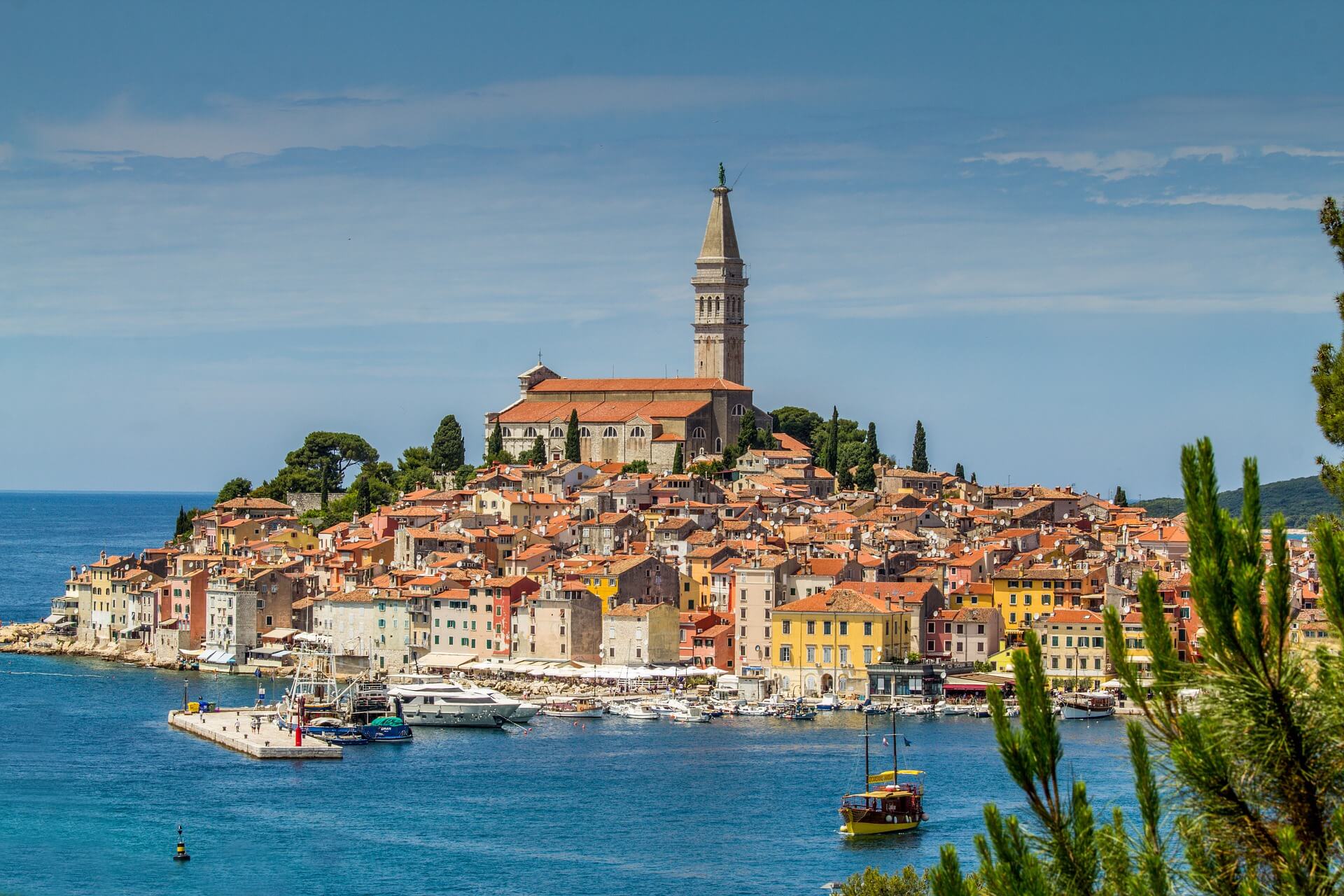
Credit: Gerald Thurner (Pixabay)
Even if new flight routes are being opened and the frequency of these are increasing as the summer season approaches, many of the tourists traveling to Croatia have to deal with the measures imposed in their own countries upon their return. For instance, tourists from many European countries had to cancel their reservations during last summer season due to the quarantine measures imposed by their governments.
As the world was hit by the third wave of the pandemic, many countries were forced to tighten measures further. Among them are numerous European countries such as Germany, which have declared Istria as a high-risk region, despite the fact that Istria is still among the European regions with the lowest incidence of infection.
On that occasion, the Rovinj Tourist Board has provided testing for guests staying in private accommodation and other smaller facilities. Testing is performed in Maistra hotels, and to register guests will need to contact the Rovinj Tourist Board by phone at +385 52 811 566 or e-mail to This email address is being protected from spambots. You need JavaScript enabled to view it..
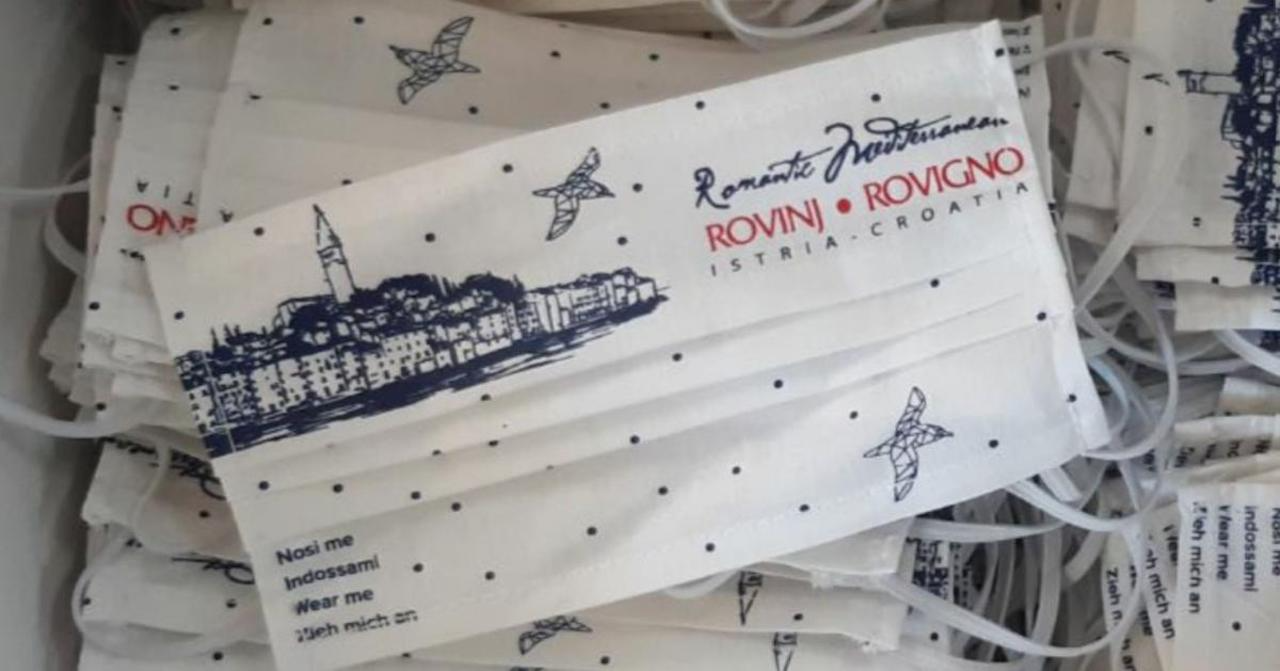
Credit: Rovinj Tourist Board
Last year the Tourist Board designed its own protective canvas face mask, which was distributed to catering employees and registered private landlords. The mask served not only as a safety measure but as an attractive souvenir for many guests as well.
In addition to masks, the Tourist Board has made a leaflet or brochure "Info COVID-19" which is intended for guests and renters, to inform guests about the procedure in case of coronavirus infection during their stay in the accommodation facility. You can find it below:
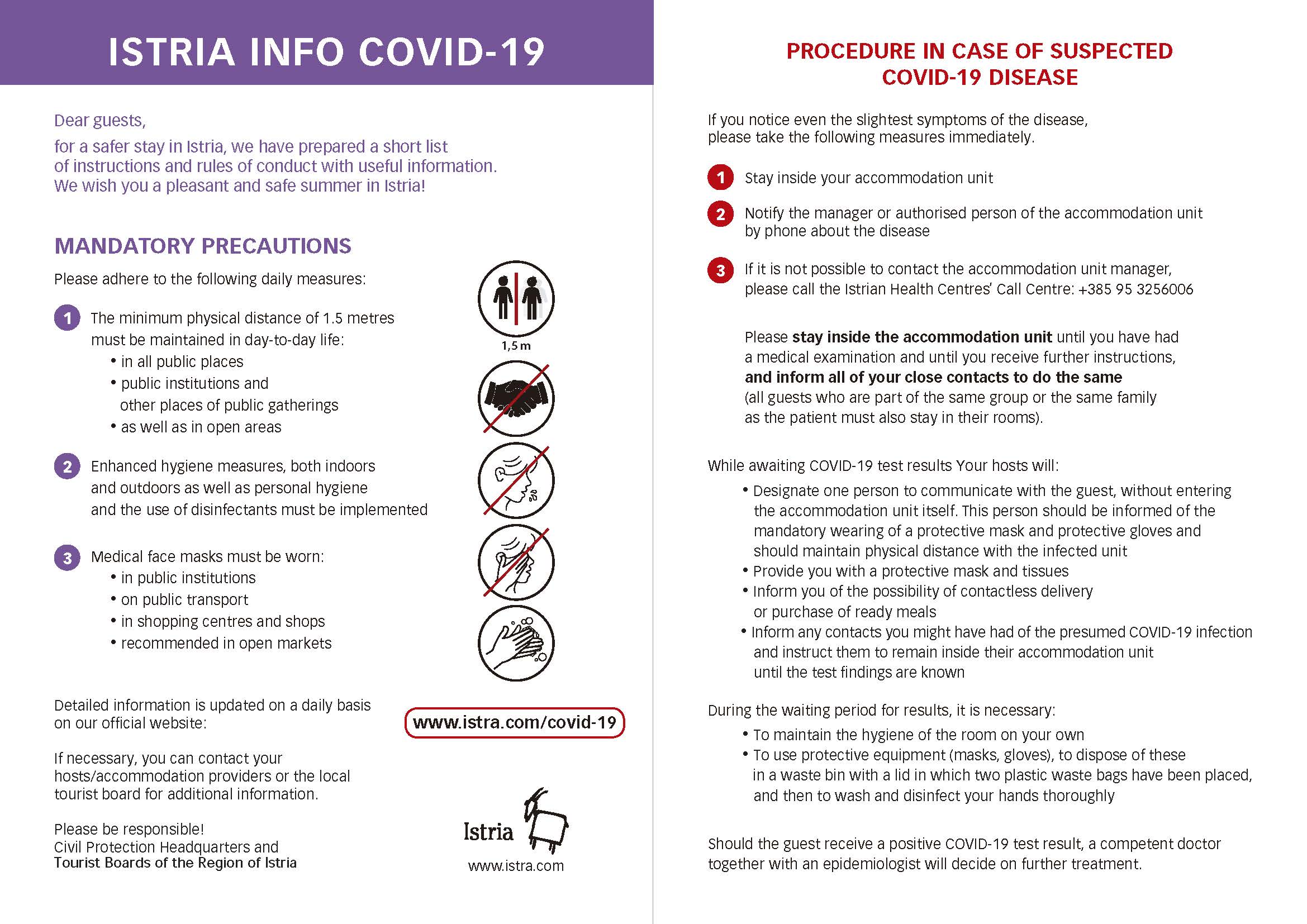
All you need to know about traveling to Rovinj can be found on our dedicated TC page.
Follow the latest travel updates and COVID-19 news from Croatia HERE.
For more on travel in Croatia, follow TCN's dedicated page.
Will Census Show More Than 149 Unpopulated Settlements?
ZAGREB, 18 March, 2021 - Croatia had 149 unpopulated settlements in the last population census ten years ago and there will likely be more in the upcoming one, it was said on Thursday at a meeting of the parliamentary environment and nature protection committee.
The committee debated a 2013-19 report on Croatia's territory which confirms that settlements in border and mountain regions continue to die out, while concentrating in central Croatia, including Zagreb.
The data were presented by Sunčana Habrun of the Physical Planning Ministry, including on planned construction and business zones.
Planned construction zones cover about 400,000 hectares, 7% of the state territory, and business- about 112,000 hectares, 2% of the state territory.
"Is that a lot? Little?" wondered Juro Brkan of the ruling HDZ.
Habrun said it was too much and that Croatia had more than enough construction zones. Those zones are "extensively" planned given Croatia's situation and demographic figures, she added.
She said it was up to local government to see how to fight off demands for expanding construction zones.
Rovinj has decided that it wants no more hospitality and tourism zones because they endanger sustainable tourism development, she said.
For more about politics in Croatia, follow TCN's dedicated page.
British American Tobacco Stays in Croatia - Say Rovinj, Agriculture Union
ZAGREB, 17 March, 2021 - Representatives of the PPDIV agriculture union on Wednesday met with Rovinj Mayor Marko Paliaga, saying afterwards that the story of the future of the Rovinj Tobacco Factory (TDR) "ended well and British American Tobacco (BAT) stays in Croatia."
Paliaga thanked the unionists for fighting for TDR workers, the City of Rovinj said in a press release.
The Kanfanar-based TDR is owned by British American Tobacco.
The unionists thanked the mayor for the cooperation and support in negotiations with BAT on keeping the plant in Kanfanar, following announcements last year that it might be shut down.
The workers need not fear for their future any longer because TDR is staying in Kanfanar, the press release said.
PPDIV president Denis Paradiš said TDR's staying in Croatia was important for Rovinj, Istria County as well as for the Slavonia region and tobacco growers. "It's important for all of Croatia."
BAT took over TDR from Adris Group in September 2015 for €505 million. Under the contract, BAT was to keep production in Kanfanar for at least five years.
Last year media reported that BAT was considering to leave Croatia due to deteriorated business conditions. In December, Prime Minister Andrej Plenković said the government's negotiations with BAT were going well and that he would do everything for BAT to keep production in Istria.
For more about business in Croatia, follow TCN's dedicated page.
10 PHOTOS: Incredible Images of the Best Croatian Artistic Photography 2021
March 4, 2021 – Following a national competition, the Croatian Photo Association have chosen the best Croatian artistic photography of the year. 10 incredible images will now represent Croatia in the prestigious Biennial of the International Federation of Photographic Art in Paris.
Following a national competition, the Croatian Photo Association (Hrvatski Fotosavez) have chosen the best Croatian artistic photography of the year. 10 incredible images will now represent Croatia in the prestigious Biennial of the International Federation of Photographic Art (FIAP) in Paris.
The International Federation of Photographic Art (FIAP - Fédération Internationale de l'Art Photographique)
The International Federation of Photographic Art (FIAP - Fédération Internationale de l'Art Photographique) is an international organization of national associations of photography. More than 85 national associations are members, comprising nearly one million individual photographers.
FIAP was founded by M. Van de Wijer of Belgium in 1946. Its first congress took place in Bern, Switzerland in 1950. At this time, one of the national photographic associations represented was that of Yugoslavia. Following the federation's break up, each of its former republics now runs its own national photography association. Continuing a 70 year tradition, they still enter the prestigious International Federation of Photographic Art Biennial.
FIAP congresses have grown so large over the years, they are now seperated into different categories and held once every two years. Black and white and nature photography have their biennials one year, and the next year colour photography gets its biennial. The competition congress visits different countries each year. The 2021 FIAP Colour Biennial will be held in Paris, France.
The FIAP Colour Biennial competition and congress is split into two parts. The oldest, and arguably the most prestigious part of the competition, sees the best photography appearing in print and displayed individually upon the walls of the host venue. 10 examples of the best Croatian artistic photography of the year have been chosen by Hrvatski Fotosavez to represent Croatia in this section of the event.
A further 20 Croatian entries will appear in the congress's other section – projected photography. These entries are submitted digitally, rather than in print, to be shown in projection at the event.
Following a national competition, the Croatian Photo Association have chosen the best Croatian artistic photography of the year to represent Croatia in the prestigious congress and competition.
The Croatian Photo Association (Hrvatski Fotosavez)
The Croatian Photo Association (Hrvatski Fotosavez) is the legal successor of the Photographic Association of Croatia, founded on March 27, 1949 in Zagreb, and the historical successor of the Croatian Amateur Photographic Association, founded on June 11, 1939 in Zagreb. Its members are individual photography clubs and societies from all over Croatia. From their ranks, the best Croatian artistic photography of the year have been chosen.
Photography and cinema club 'Picok' from Đurđevac (Foto kino klub Picok, Đurđevac)
For the 2021 entries to the Colour Photography Biennial in Paris, special mention must be given to the remarkable achievements of one society of photographers from the town of Đurđevac. Of the 30 photographs selected to represent Croatia in this year's competition, no less than 8 of them came from members of this one photography society. In addition to Mato Zeman and Željko Car, who are interviewed below, works by Ivan Hećimović and Ivan Nemet were also selected. According to these results, Photography and cinema club 'Picok' from Đurđevac are the most successful association in this year's Croatian Photo Association competition. Coincidentally, the four Đurđevac photographers had a large joint exhibition of award-winning photographs in Đurđevac just last year. After the event, all 40 works exhibited were donated by the photographers to the city of Đurđevac. Bravo Picoki!
FIAP, Hrvatski Fotosavez and the 10 photographers chosen for 2021 FIAP Colour Biennial have kindly given Total Croatia News exclusive permission to reproduce this year's print entries. Here, we profile the best Croatian artistic photography of the year and meet the photographers.
The Best Croatian Artistic Photography 2021
Damir Rajle 'Sunshine Road'
 Croatian artistic photography by Damir Rajle
Croatian artistic photography by Damir Rajle
My name is Damir Rajle. I am semi-professional photographer from Osijek. My primary profession is cartographer and land surveyor, mostly involved in digital orthophoto and topographic maps. My photograph 'Sunshine Road' is a wine road in Baranja. I am very often in that exact place. But, that day, the setting sun was directly ahead and so I tried a couple of shots. Suddenly, a boy came along, silhouetting himself against the sunlit road. The naturally hilly landscape of the vineyard adds to the composition.
Dušan Grbac 'Žuti'
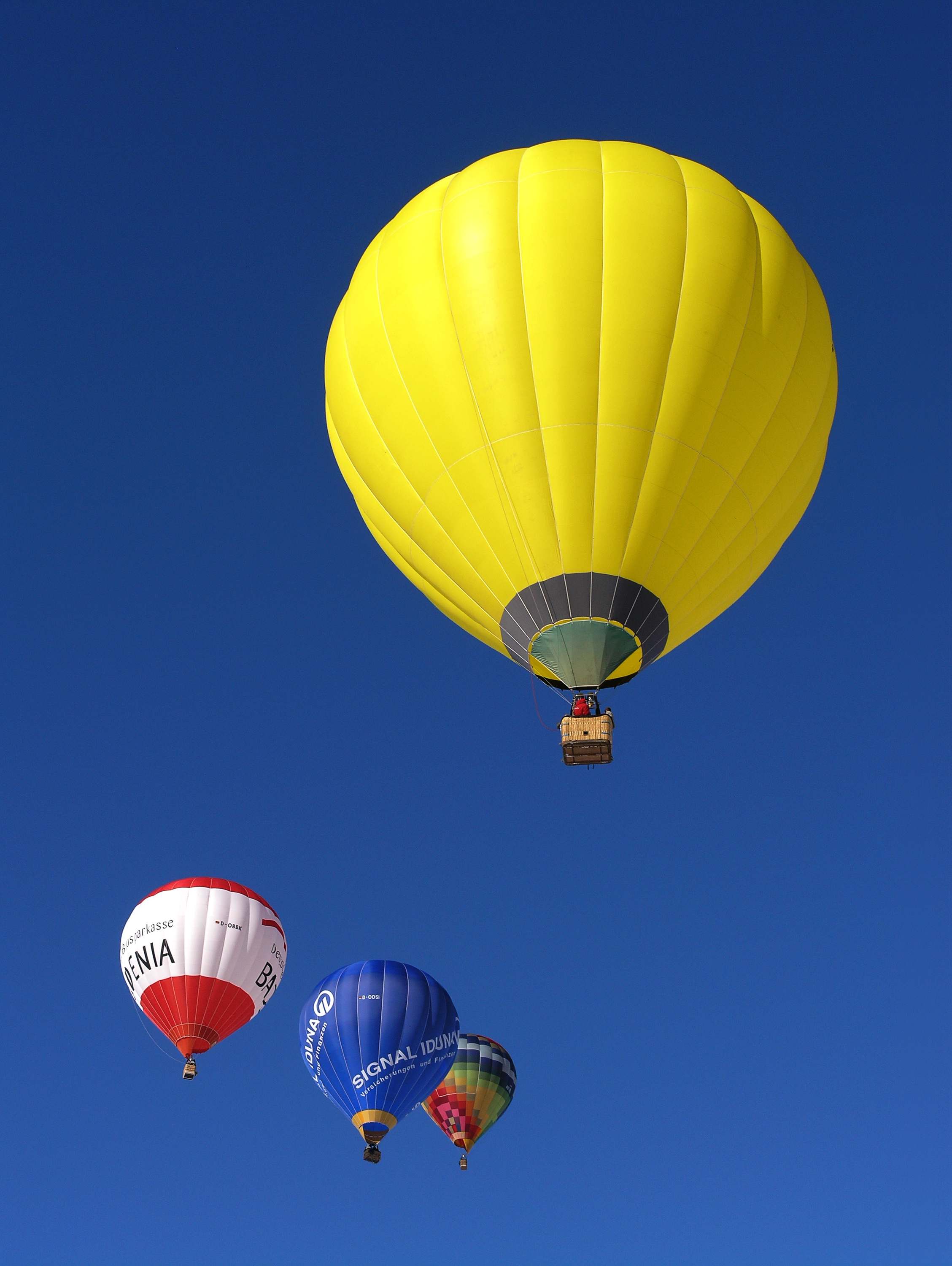 Croatian artistic photography by Dušan Grbac
Croatian artistic photography by Dušan Grbac
My name is Dušan Grbac and I was born in 1960, in Rovinj. I started shooting and developing black and white photography in 1975. I developed the photographs on my own in a small, analogue darkroom at home. In 1982 I became a member of the Photo Club Rovinj and thereafter participated in a number of exhibitions. In 2002 I embraced digital photography. I actually work as an IT specialist. In my free time, I like to engage in photography and I've held dozens of lectures and workshops about photography. I'd really like to pass on to others everything I've learned about photography over the years. 'Žuti' (Yellow) was actually taken in January 2006 in the Italian town of Dobbiaco. The annual balloon show was held at a temperature of -16 °C! This made the sky crystal blue. I couldn't resist that tonal contrast, the colours... and 'voila'.
Mirjana Spajić Buturac 'Saturn'
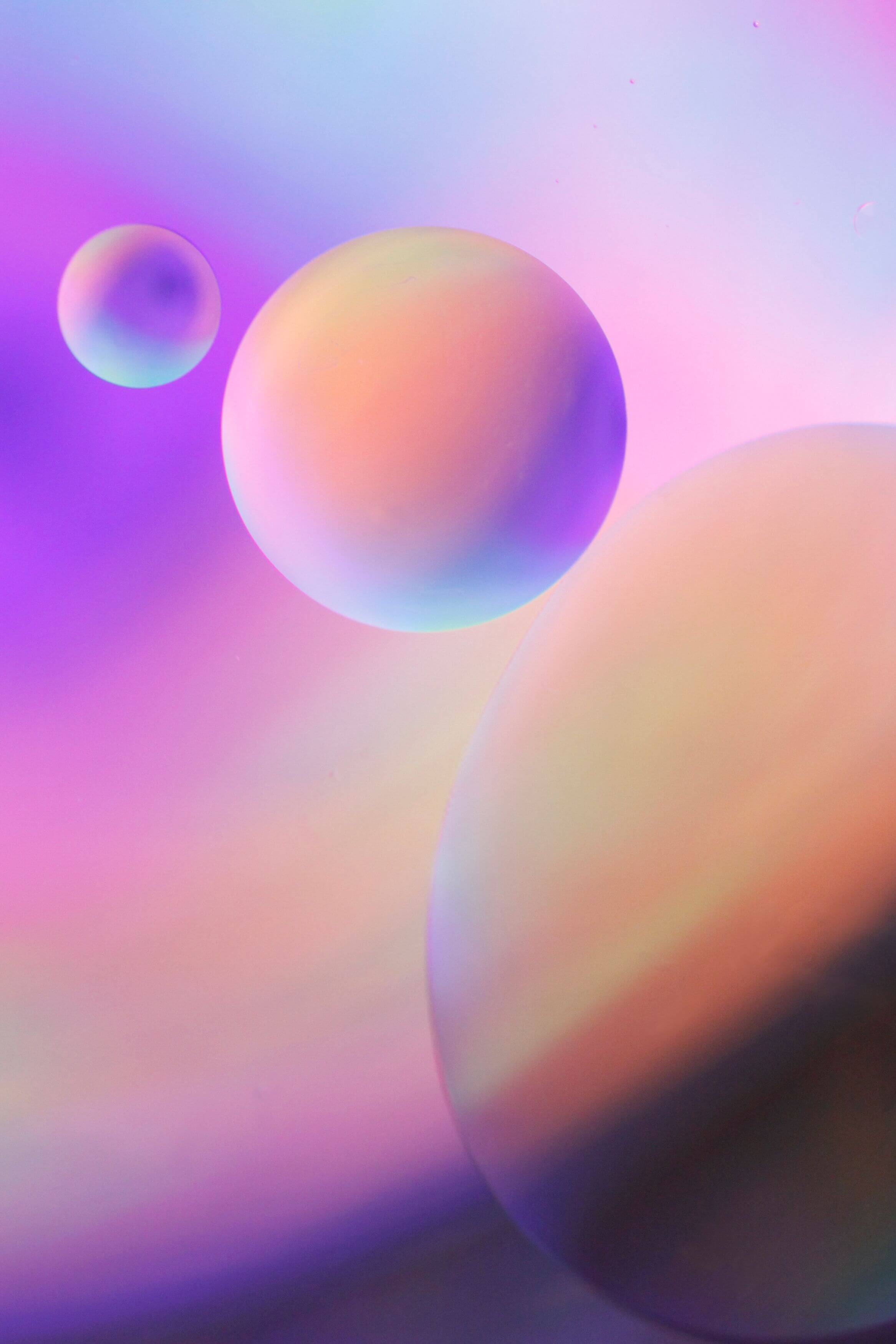 Croatian artistic photography by Mirjana Spajić Buturac
Croatian artistic photography by Mirjana Spajić Buturac
My name is Mirjana Spajić Buturac. I'm originally from Vinkovci, but I have been living in Zagreb for 20 years. I studied in Osijek and by profession, I am a professor of mathematics and informatics. I've been interested in photography since my student days. However, it was a colleague, Professor Vladimir Šimunić that truly awoke my passion for photography in me and in 2014 I certified as a photographer, enrolled in Fotoklub Zagreb and started participating in photography competitions. I took an online course at Udemy to perfected my use of Photoshop and photo processing. I work at the School of Crafts for Personal Services in Zagreb, which, among other things, has a photography major, and in addition to mathematics and computer science, I now also teach digital photography. I am so happy that photography has become a part of my job! 'Saturn' was taken in December 2020. It shows drops of olive oil in water. Under the influence of ultraviolet light and a fluorescent poster under the bowl of water, the oil droplets took on a three-dimensional effect. My seven-year-old son Leon noticed that the largest droplet had a dark ring, like Saturn. That's how the photo got its name.
Mato Zeman 'Spring Fields'
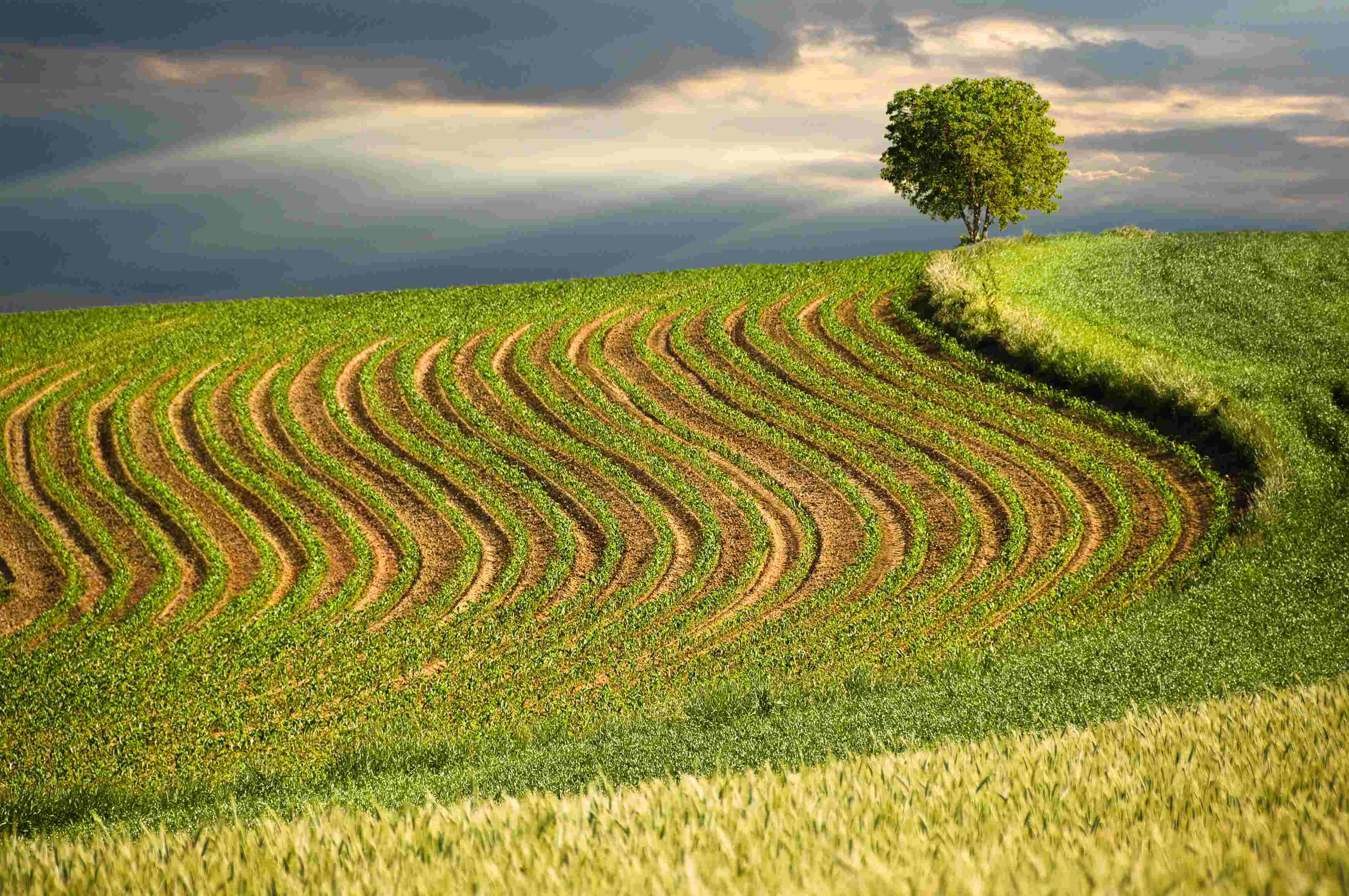 Croatian artistic photography by Mato Zeman
Croatian artistic photography by Mato Zeman
My name is Mato Zeman and photography has been my hobby for long time. I live in Kloštar Podravski, a small village in Podravina, between the river Drava on the north and Bilogora mountain on the south. In my full0time job I worked in the 112 Emergency Centre in Koprivnica, but I've now been retired for 2 years. Photography is my hobby for a long time. I've participated in several international photo contests. In 2015, FIAP awarded me the honorary title FIAP Artist and three years later the title EFIAP (Excellence Fédération Internationale de l'Art Photographique). I am a member of the Photo and Cinema club 'Picok' in Đurđevac. I'm also a member of the local artistic association 'Kloštranska paleta' in my home village. Two of my works were selected for FIAP 2021 Biennial of Colour Photography in France and will represent my country. I am very proud of this. The one appearing in print 'Spring Fields' was taken at the fields of young corn on the slopes of Bilogora. The rows of corn are in a nice S line, the sky is partly cloudy with the sun shining through.
Nenad Martić 'Red, White and Blue 2'
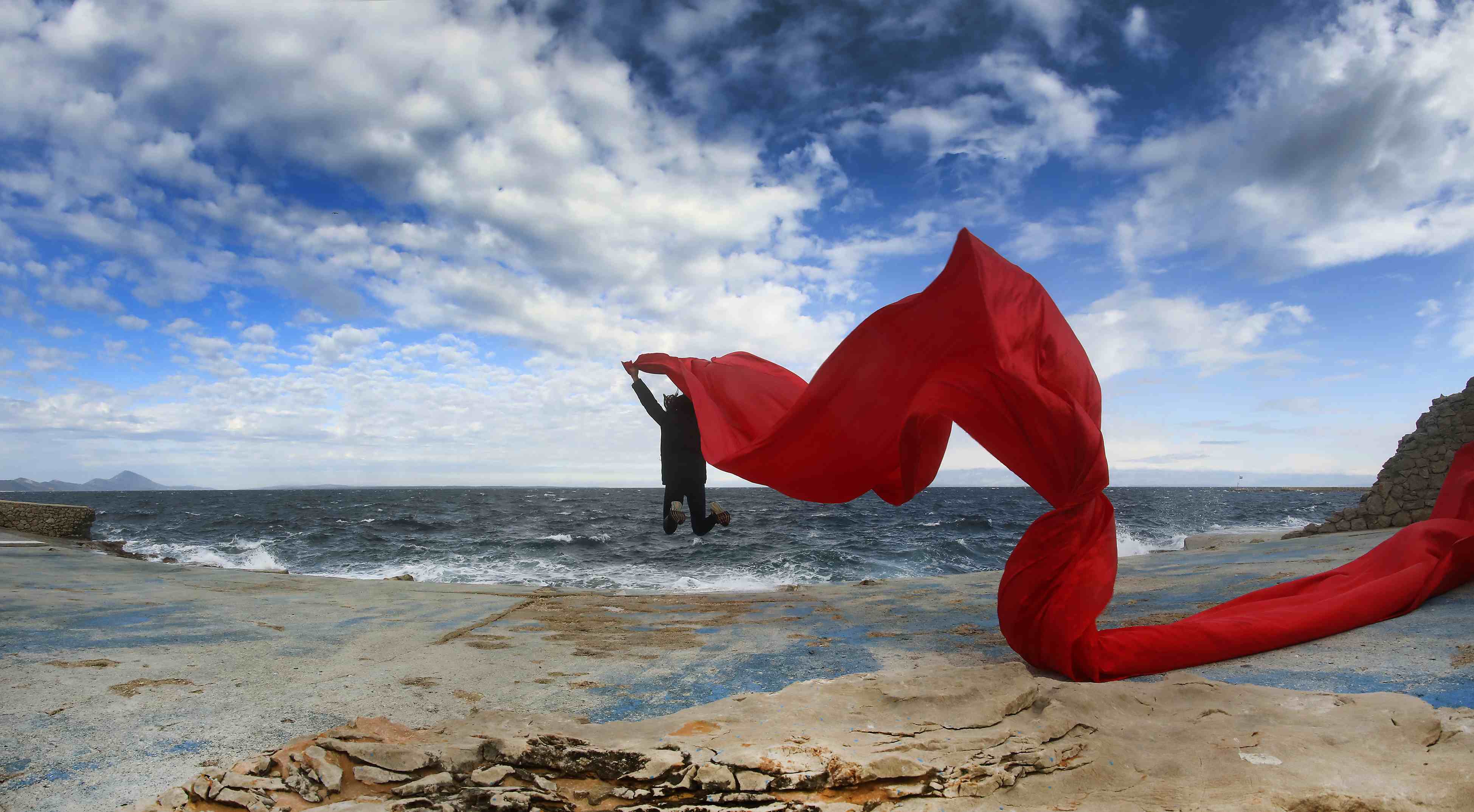 Croatian artistic photography by Nenad Martić
Croatian artistic photography by Nenad Martić
My name is Nenad Martić. I was born in 1951 in Zagreb, where I graduated from the Department of Fine Arts at the Faculty of Education, University of Zagreb.I devoted most of my professional career to graphic design and illustration, beginning in the 1980s with the Start and Svijet magazines. The second half of my career was marked by the gradual introduction of a new artistic expression; digital photography. Free of assignment of specific commissions and deadlines, artistic photography became a passion. I dedicated myself to it for the last ten years. I take different kinds of photographs, but I most prefer street photography. It's a kind of documentary photography, focusing on the nuances of human gestures and street context, capturing and conveying the moment to those who are not there. 2014 was a turning point for me because I joined Photo Club Zagreb. Thereafter, I had three solo exhibitions, was included in over a hundred group ones and won several international and national awards and nominations. These included the Ferdinand Soprano Grand Prix and the Viktor Hreljanovic Award from Photo Club Rijeka in 2019, most successful author and the most successful Croatian author at the 39th Zagreb Salona in 2020 and I won the prestigious Tošo Dabac Award 2019 for outstanding contribution to photography in Croatia. My photo 'Red, White and Blue 2' was taken on the island of Lošinj. The model is my daughter. It is one of a series of photographs taken with red cloth.
Silvija Butković 'Together'
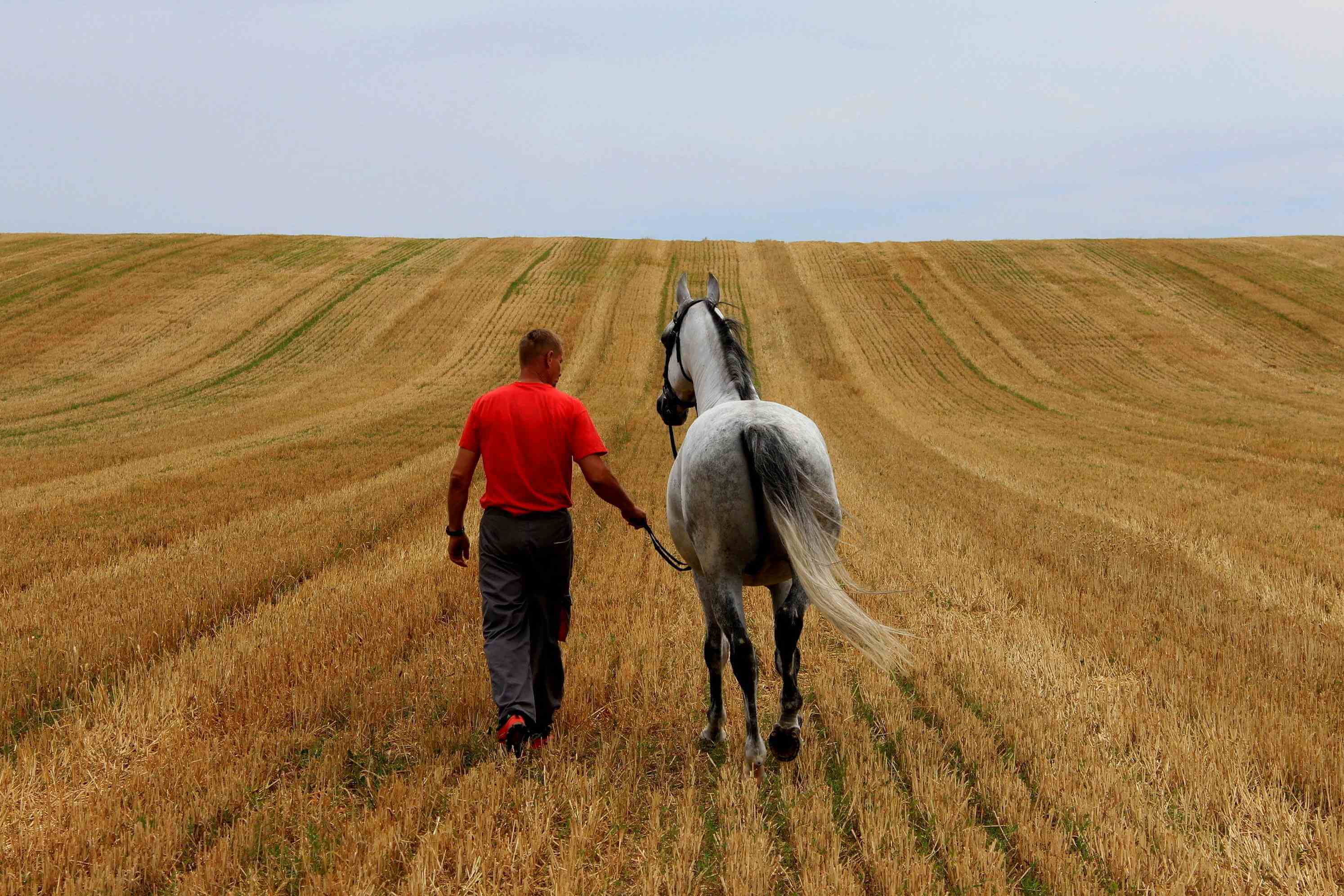 Croatian artistic photography by Silvija Butkovic
Croatian artistic photography by Silvija Butkovic
My name is Silvija Butkovic and I was born in 1964 in Osijek, Croatia. As a child, I lived on the island Lošinj. I returned to Slavonia when I entered University. I now live and work in Đakovo as manager of tourism an public relations at the State Stud Farm Đakovo (National Lipizzan Stud Farm Đakovo - Državna ergela Đakovo). Language and photography are my great loves. Lately, I've been making photo haigas, a Japanese combination of poetry and photography. The World Haiku Association recently awarded me the title Master of Haiga for my work. You can see some of it on their website www.worldhaiku.net/haiga. Lošinj and the heart of the Slavonian plain are a constant inspiration. I also adore horses and I love watching them through the camera. I'm a member of 'Photo-cinema Club Djakovo', 'Photo-Club Rijeka' and 'Matica Hrvatska'
Željko Car 'Spring'
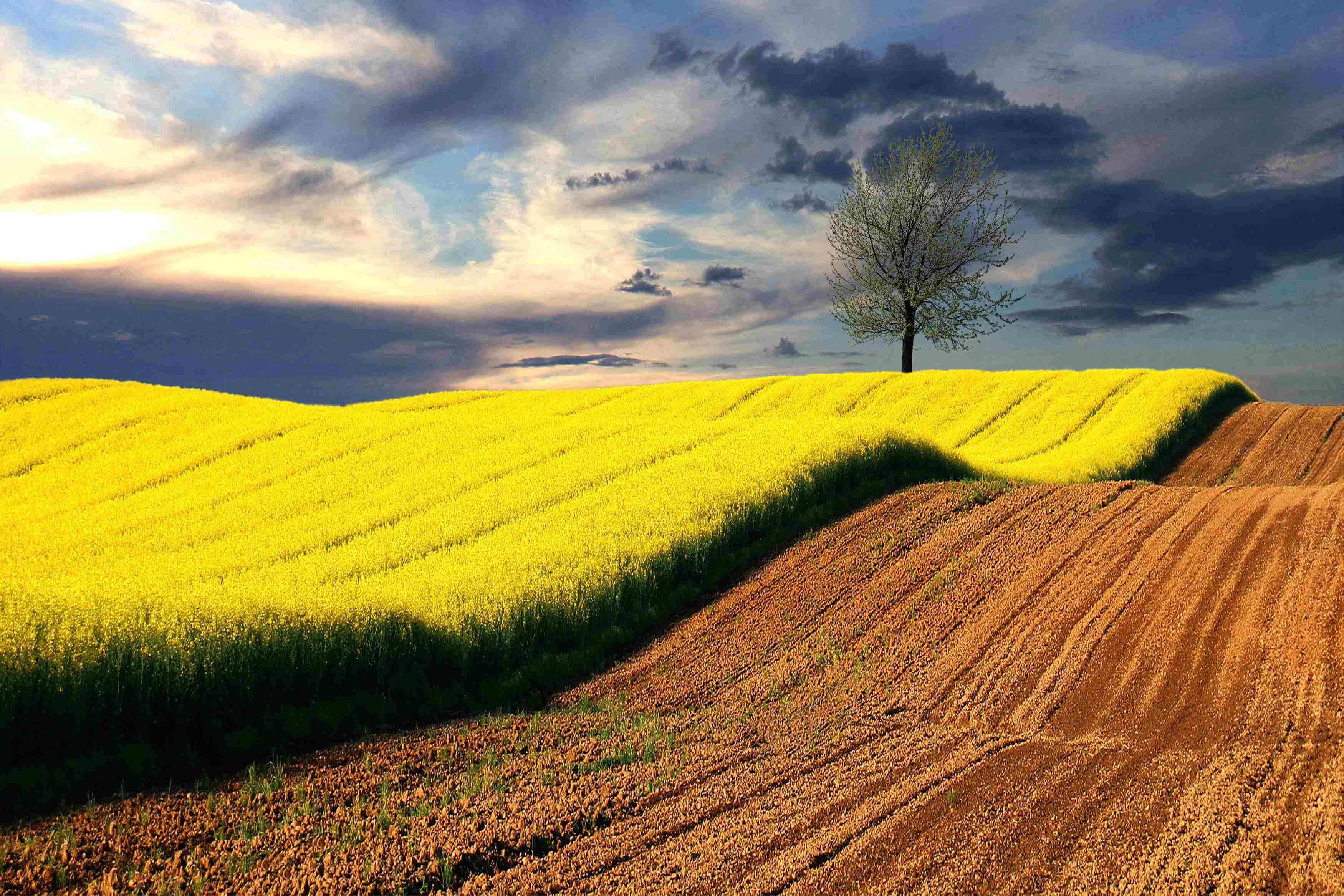 Croatian artistic photography by Željko Car
Croatian artistic photography by Željko Car
My name is Željko Car. I'm a lawyer by profession. I first published photos in newspapers (I was a correspondent for several). Since 1984 I've participated in exhibitions in many countries around the world. I have more than 300 awards and diplomas, and I received the honorary title of EFIAP. Two of my photos were selected for the 2021 Biennial of Colour Photography in France - 'Spring' and 'Snow on the river bank'. Both photos were taken near Đurđevac, the city where I live. With 'Spring' I wanted to show the beauty and ambient values of the area where I live. It was actually taken in the spring of 2000.
Aleksandar Tomulić 'Valencia 5'
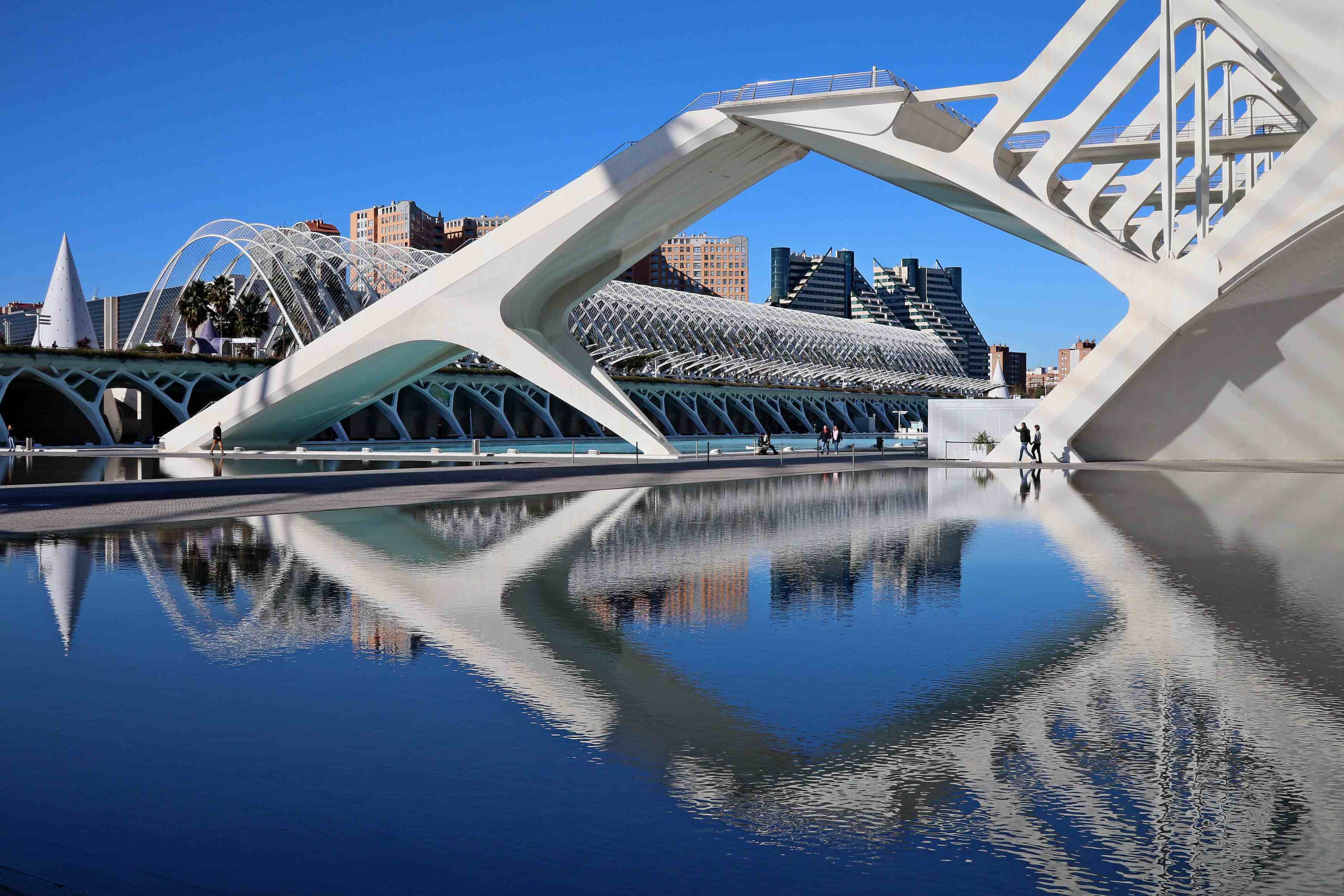 Croatian artistic photography by Aleksandar Tomulić
Croatian artistic photography by Aleksandar Tomulić
My name is Aleksandar Tomulić and I'm from Rijeka. I'm a semi-professional photographer. My main profession is IT. I've been taking photos since I was a kid. I was born in 1967. I became more seriously involved in photography in 2004. It's the magic of capturing an unrepeatable moment that fascinates me, and the feel for light and composition. I prefer street photography and seaside motifs, and I like to experiment with abstract images. Since 2013 I've volunteered to give classes and workshops. I'd like to pass on what I've learned about photography. I've had 15 one-man shows, participated in over 500 group shows and received over 320 awards. The Croatian Photo Association have selected my work ten times to represent Croatia at FIAP Biennales. I'm a member of 'Fotoklub Color' and 'Fotoklub Pag.' My photo 'Valencia 5' was taken, of course, in Valencia in the City of Art and Science. I took the shot in 2018. That new part of Valencia is the concept of famous architect Santiago Calatrava.
Ante Jaša 'Knot in Passage'
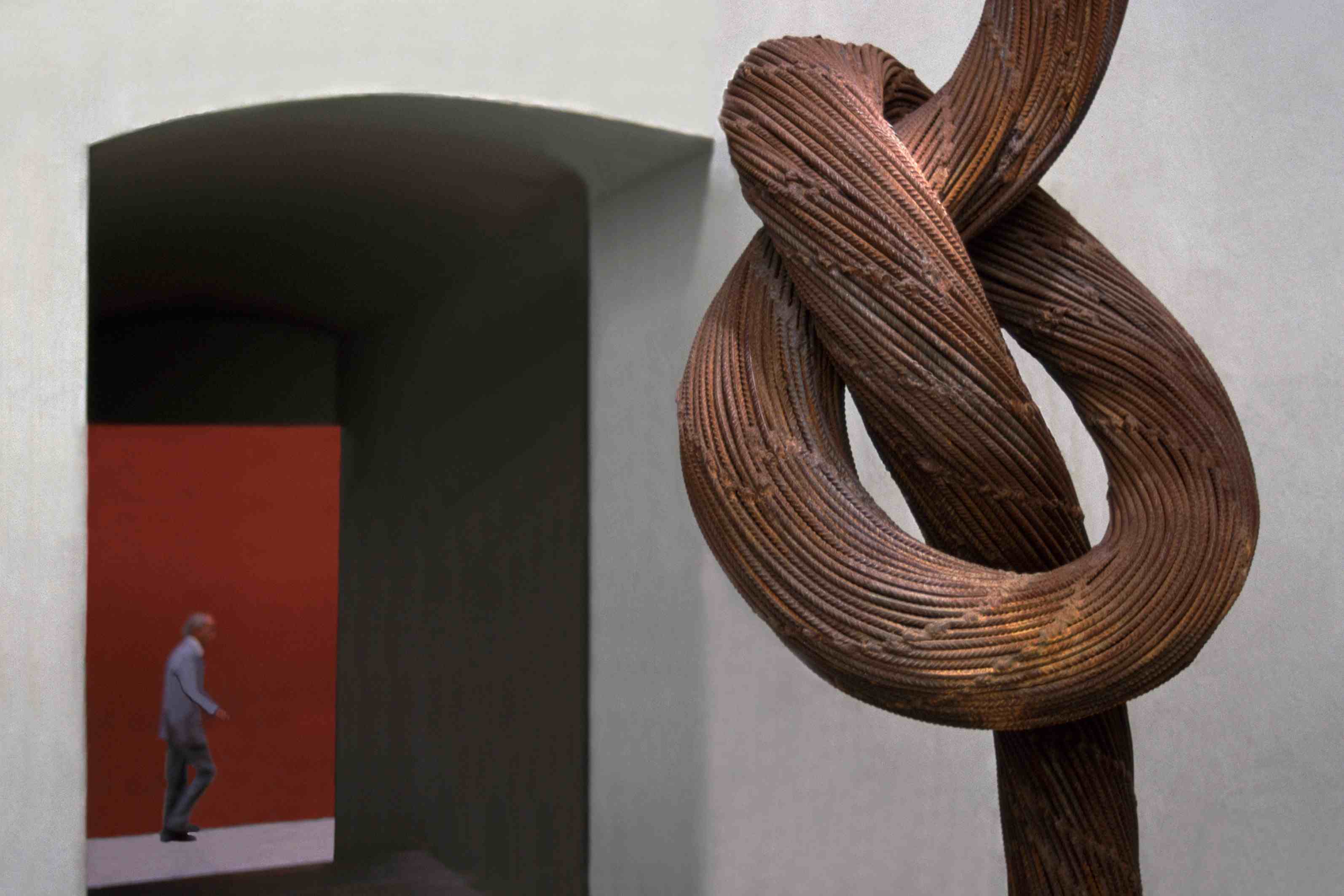 Croatian artistic photography by Ante Jaša
Croatian artistic photography by Ante Jaša
My name is Ante Jaša. I was born on 19th October 1951 in Kukljica-Zadar. From the earliest days of my childhood, I played with a 'box camera' we had at home. My grandfather bought it in New York. He could never have known this would lead to his grandson having solo photography exhibitions in out home town. In 1970, my photography and writing started to be published in dailies (newspapers), weeklies and journals. By 1999 I'd progressed to be on the editorial board of the feuilleton “Mareta” (Wave) in the paper “Narodni list” - Zadar. I've exhibited my works at 418 collective exhibitions on every continent and have received numerous awards. I'm a member of the photo clubs 'Zagreb', 'Zadar' and 'Kornat' Kukljica. Sea and stone are the main motifs of my work. There's an inherent tension between them which I'm exploring. By taking photographs of both traditional and modern ways of life on the islands near Zadar, I show their natural ambience, the sea as well as on the mainland around Zadar. My photo 'Knot in Passage' was actually taken in 2015. The photo shows the entrance to the Art Gallery in Zadar. In the courtyard of the entrance was a modern metal sculpture. I put the sculpture in the foreground. The entrance is wide open and a passerby can be seen on the street. The sculpture seems to be inviting people to enter the gallery.
Ivan Nemet 'Field Geometry'
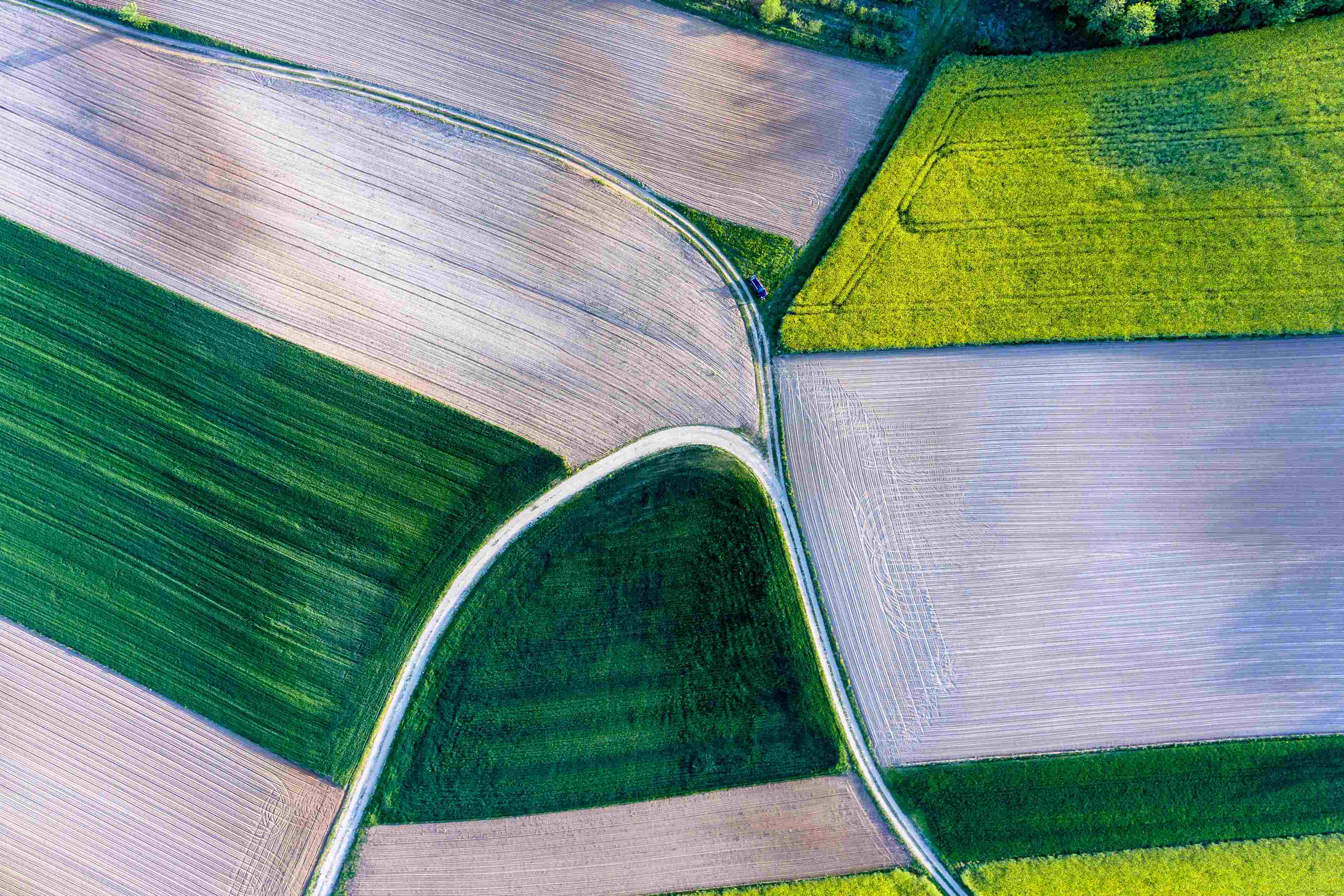 Croatian artistic photography by Ivan Nemet
Croatian artistic photography by Ivan Nemet
My name is Ivan Nemet. I was born in Kloštar Podravski. I am retired and I spent my entire working life working on oil wells all over the world. Photography has been a hobby since my early days. I love all kinds of photos, but my favourite is landscape photography. Over the last few years, I’ve quite often been taking photos with a drone. Photographs from a bird's eye view are often interesting because they reveal compositions that cannot be seen from the ground. I've participated in various international photography exhibitions, one of them being this year's 29th Biennale in France. The Croatian jury selected two of my photos. They were both taken using a drone. The name of the first photo is 'Reed car'. It was made in the winter on the mountain Bilogora. The name of the other photo is 'Field Geometry'. The emphasis is on the lines created by the action. Both were made not far from where I live, in the continental part of Croatia, between the river Drava and the small mountain Bilogora. The name of this part of Croatia is Podravina.
For the latest travel info, bookmark our main travel info article, which is updated daily.
Read the Croatian Travel Update in your language - now available in 24 languages.
People Also Ask Google: How to Get to Istria, Croatia in 2021?
February 17, 2021 – In Google's "People also ask" feature, the hard questions are the ones that start with "how." It is not always easy to find answers how to do something or how to get somewhere. However, in this article, we will try to explain how to get to Istria, the biggest and famous Croatian peninsula.
Located in the most western part of Croatia, Istria is a peninsula known for its rich cultural heritage, as well as it's delicious gastro offer that includes world's best wine, olive oil, and truffles. Last year, Istria was named world's best olive oil region for the sixth consecutive year, which is one more reason why Istria is an unavoidable place to visit when in Croatia.
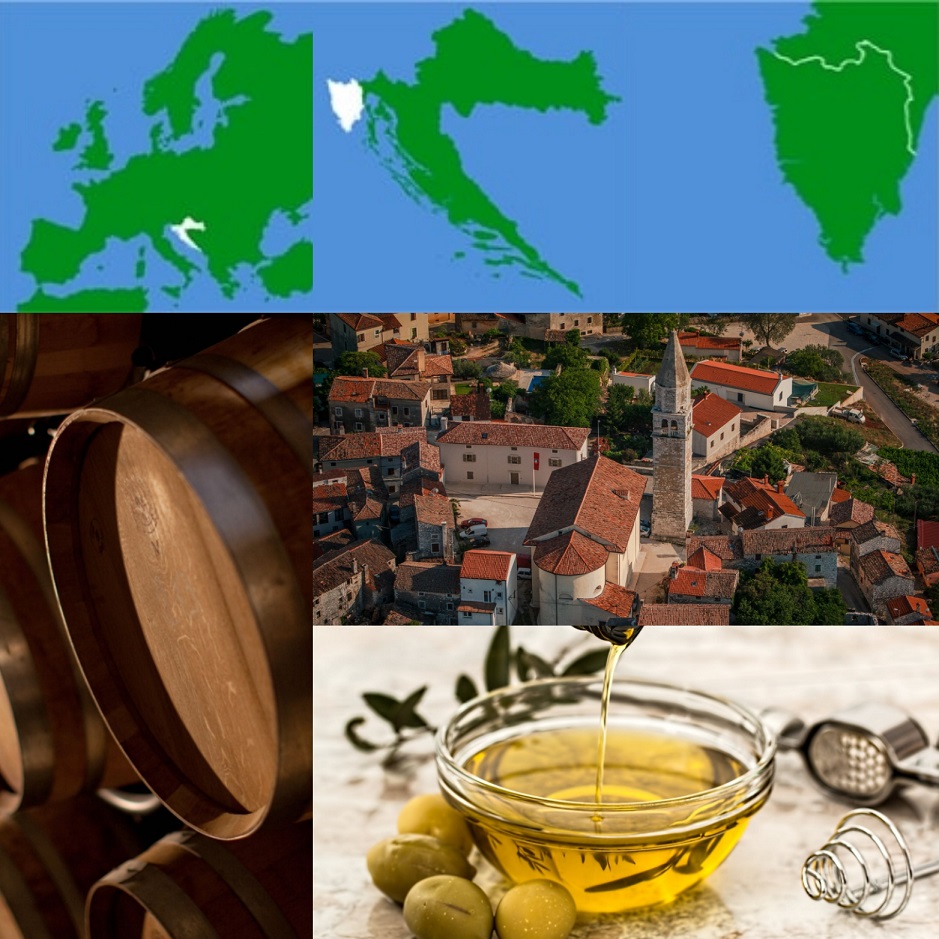
Sources: Istria.hr, Pexels, Romulić and Stojčić
We will let you explore the charms of Istria for yourself, but first, we will try to help you how to get to Istria.
How to get to Istria Croatia by car?
Istria is one of the best, if not the best traffic-connected Croatian coastal region. Thanks to its geographical position, it achieves a record number of tourist arrivals and overnight stays every year, and the cities of Poreč and Rovinj are at the very top of Croatian tourist destinations.
The largest number of tourists come to Istria by land, by personal vehicles, from the close countries of Germany, Austria, and Italy. If you're coming to Istria from those countries, or from that direction, you must pass through Slovenia.
There are four main border crossings with Croatia and Slovenia in Istria. The first ones are Plovanija and Dragonja/Kaštel, from the direction of Koper, marked in red on the photo below.
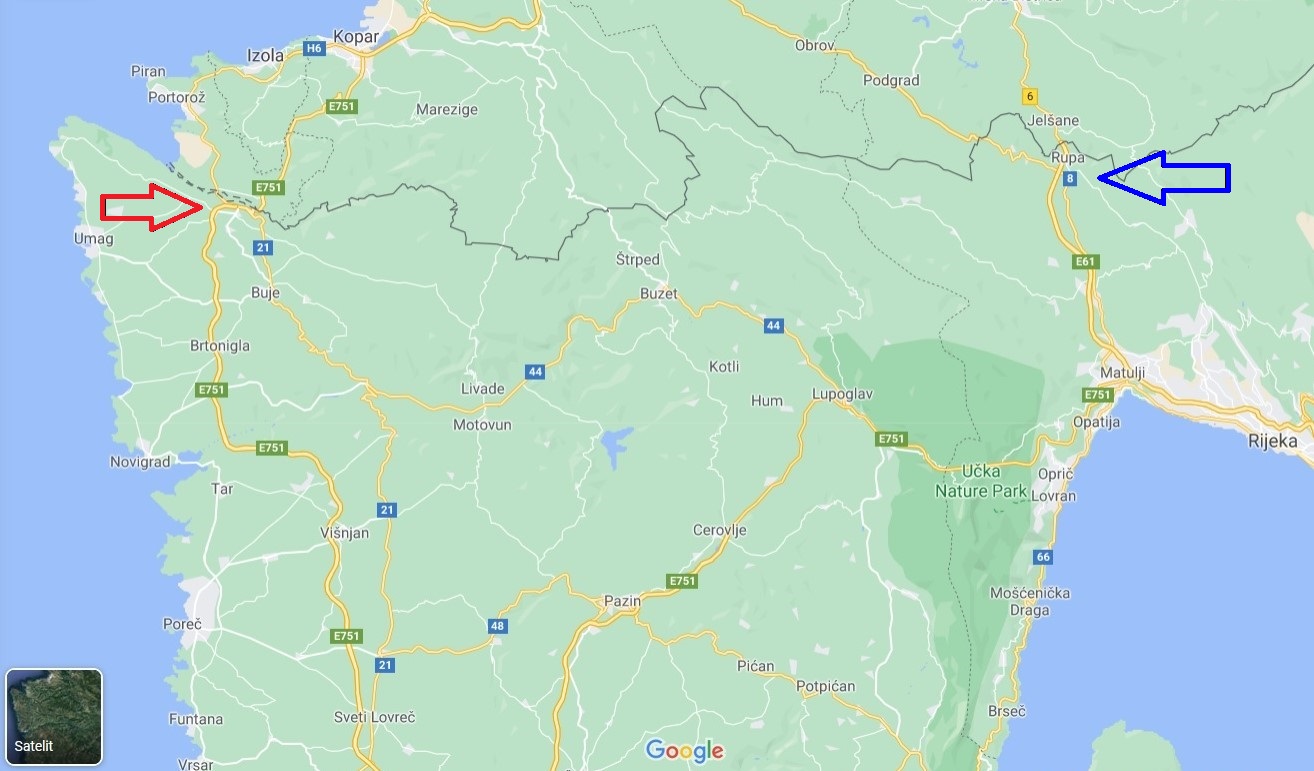
Screenshot Google Maps
The road to Plovanija goes along the Slovenian shore, and the border crossing Dragonja/Kaštel is on the road E751. After the Croatian border, that road connects with the most famous and most important road in Istria – the so-called Istrian Y, a Y-shaped highway, which connects all parts of Istria.
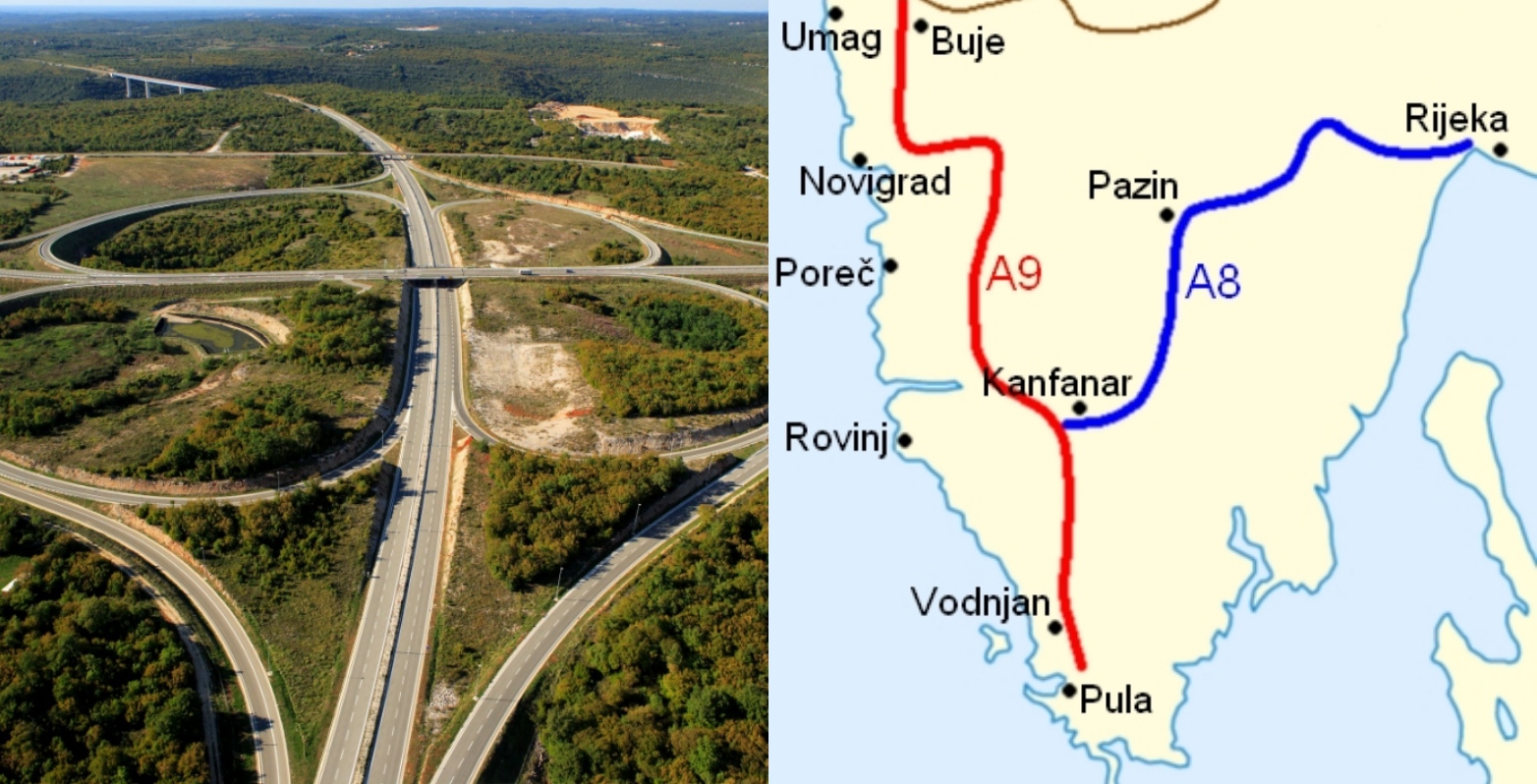
On the left: Center of Istrian Y in Kanfanar (Romulić and Stojčić) / On the right: the map of Istrian Y (Wikipedia)
That part of the Istrian Y, marked in red on the photo below, goes along the western shore, and it is a highway A9 from the Slovenian border to Pula. It connects Istrian cities of Umag, Novigrad, Poreč, Rovinj, and Pula. However, the highway itself is a little away from these cities, so you will have to turn to state roads to reach them.
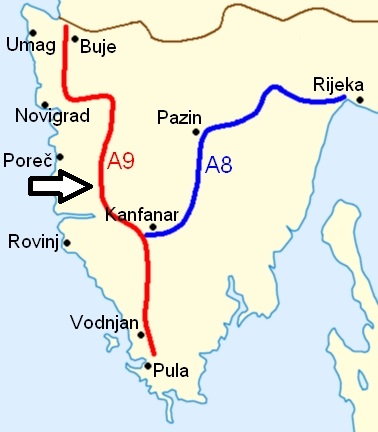
A9 highway, a part of Istrian Y, marked in red / Wikipedia
The second two important - and also the busiest - border crossings in Istria are Pasjak and Rupa, marked in blue on the first photo. Although they are located in the Primorje-Gorski Kotar County, they are a gate to Istria County.
As shown on the photo below, the highway E61 goes to Croatia via the Pasjak crossing border from the direction of Trieste in Italy. If coming from the direction of Ljubljana, you must cross the Rupa crossing border. Highway E61 (in Croatian: highway A7) from both Pasjak and Rupa end in Matulji (marked in red) near Rijeka, where it connects with the second part of Istrian Y – highway A8 that goes to Kanfanar, the center point of Istrian Y.
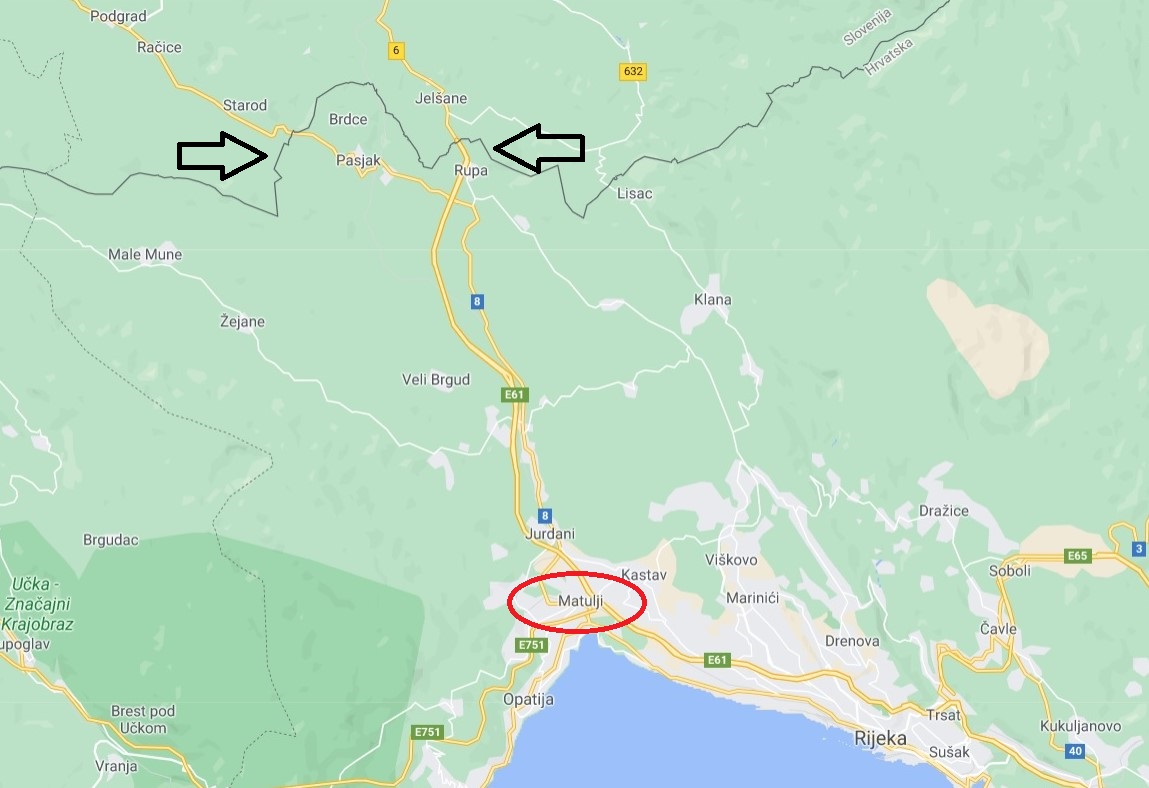
Screenshot Google Maps
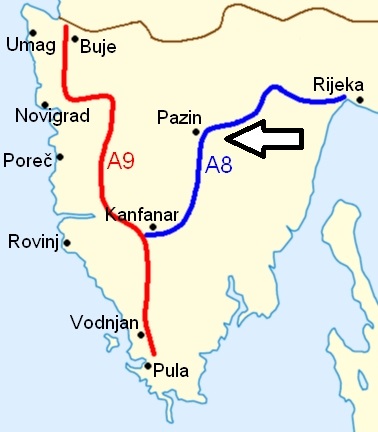
A8 highway, a another part of Istrian Y, marked in blue / Wikipedia
Remember, once you reach Istrian Y, you can reach any part of Istria. Istrian Y is actually a system of two highways, A8 and A9 – learn more about the Istrian Y.
Other Slovenian-Croatian border crossings are Bregana near Zagreb and Macelj near Krapina, from where you can go to Istria via highways E59 and E65.
How to get to Istria by plane?
The only airport in Istria is the one in Pula, while the other close airports are in Friuli Venezia Giulia Airport in Trieste, Marco Polo Airport in Venice, and Treviso Airport in Italy, Jože Pučnik Airport in Ljubljana in Slovenia (also known as Brnik Airport or Fraport Slovenia), Zagreb Franjo Tuđman Airport and Rijeka Airport in Croatia.
Pula Airport welcomes both charter and scheduled flights. Before many flights were canceled due the pandemic, Pula Airport had a solid tourist traffic. One of the most popular airline in Pula was Ryanair, offering cheap flights to some of the biggest European cities. However, the traffic in Pula Airport dropped by 89.6 percent in 2020, compared to the record 2019.
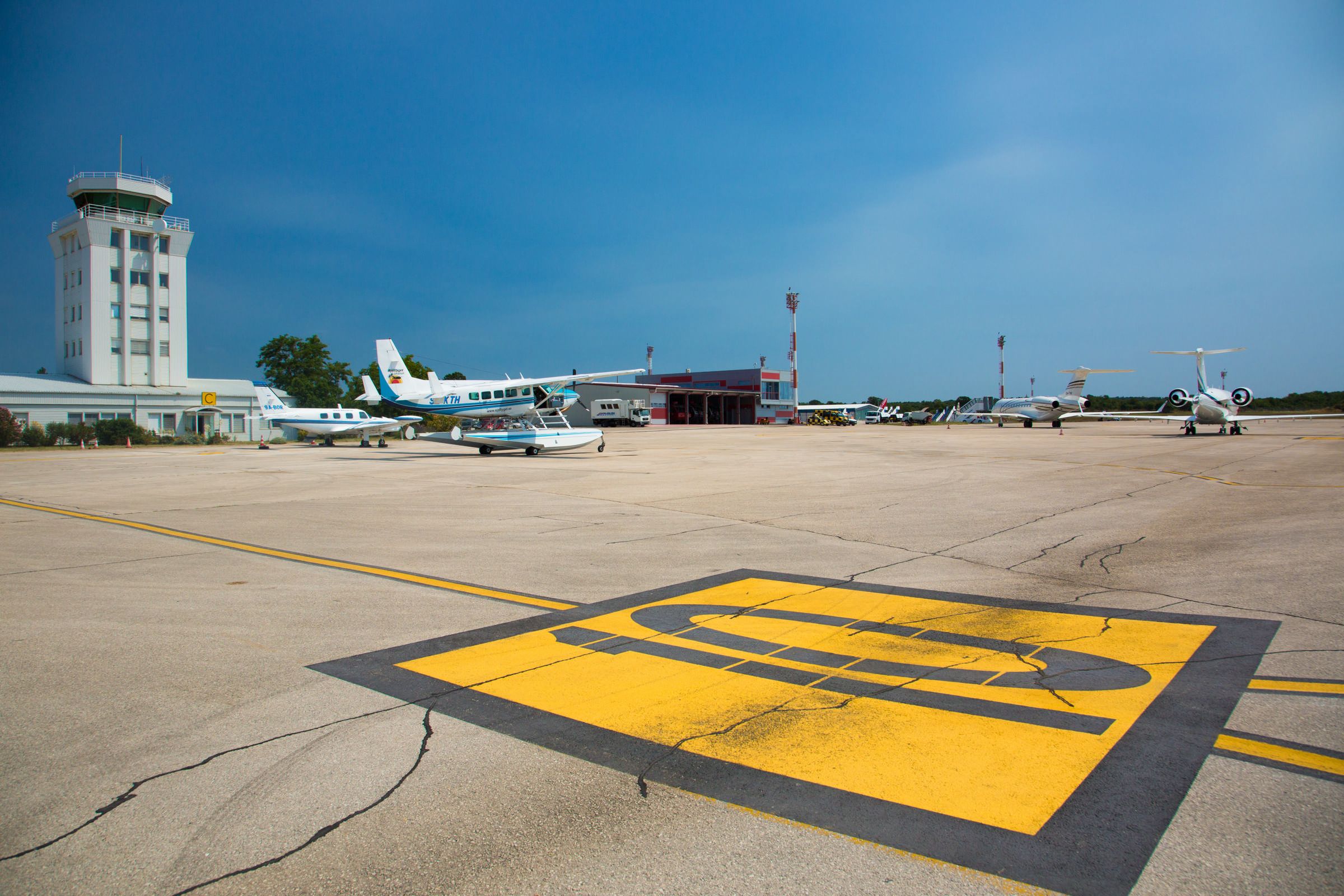
Pula Airport by Romulić and Stojčić
Airlines operating to Pula Airport in 2021 are Air Serbia, British Airways, Croatia Airlines, EasyJet, Eurowings, Finnair, Jet2.com, Lufthansa, Norwegian, Ryanair, S7 Airlines, TUI, Volotea, and Wizzair.
In 2021, it will be possible to come to Pula, Istria by flights from Belgium, Croatia, Denmark, Finland, France, Germany, Ireland, the Netherlands, Norway, Russia, Scotland, Serbia, Sweden, Switzerland, Ukraine, and the UK.
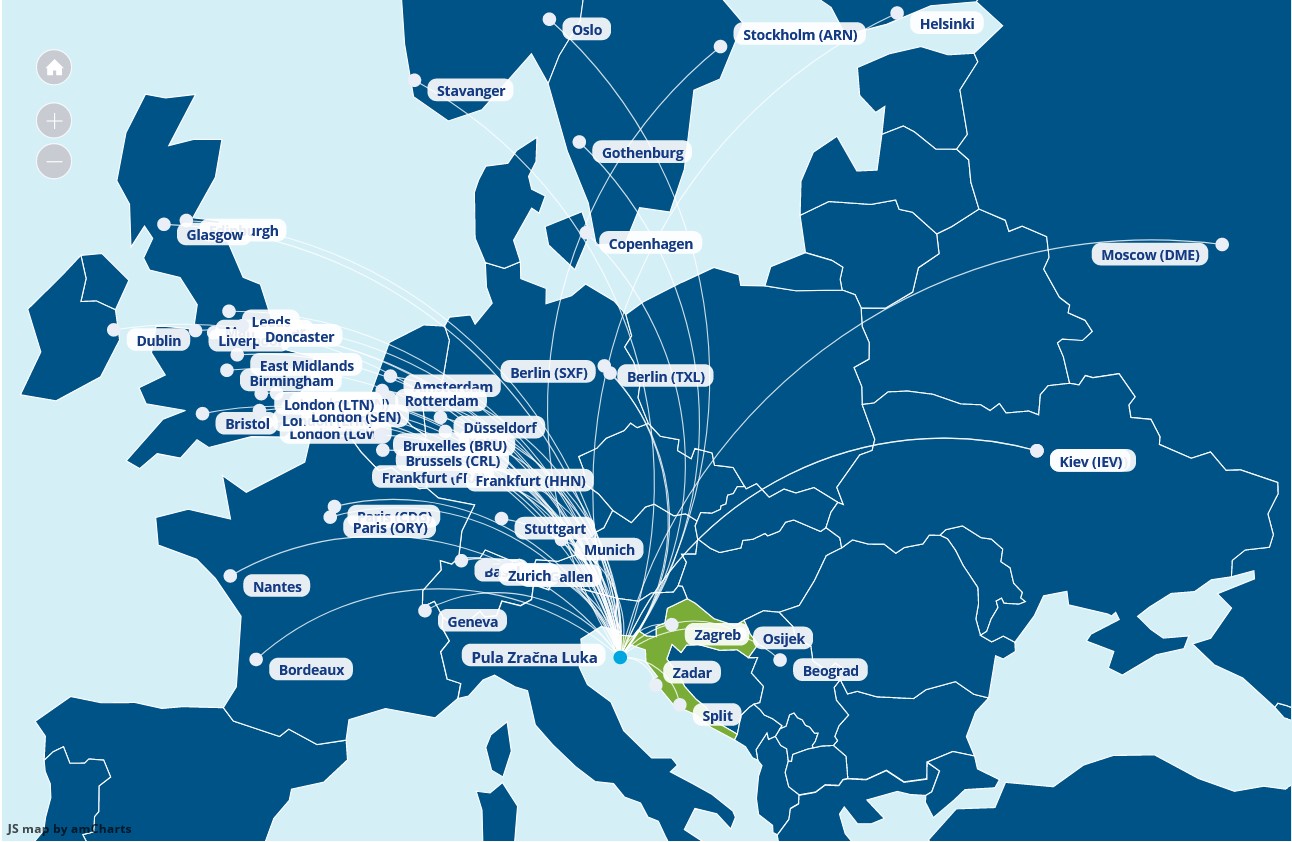
Screenshot Pula Airport
Follow TCN's dedicated page for the newest information about flights to Croatia.
How to get to Istria by bus?
If you come from neighboring countries, the bus may be a good option to get to Istria. Since northern and western Croatia is well-connected with northern Italy, you can get to Istria by bus from Trieste to Buje, Poreč, Rovinj, Pula, along with other places on the way. The bus from Trieste to the western part of Istria, as well as to Rijeka, operates throughout the year.
There are also bus lines from Venice to Pula by the Pula-based bus company FILS, operating the whole year. Another Pula-based bus company Brioni Pula provides bus services from Padova (with stops in Venice and Trieste) to Vodnjan, Rovinj, Buje, and Pula. All the bus lines from Italy to Croatia can be found here (in Croatian).
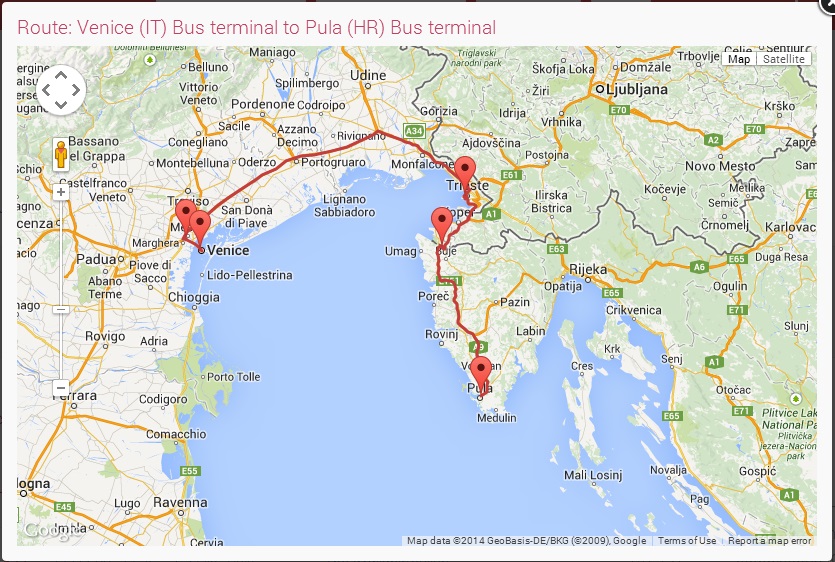
Bus routes from Venice, Italy to Pula, Croatia / Buscroatia.com
Istrian bus companies Brioni Pula i FILS also provide bus lines from many Croatian cities, mostly from the capital of Zagreb. If you're coming from continental Croatia, Istria is the closest seaside region to visit. There are many bus lines, especially during summer. You can find them also on the Flixbus and Arriva bus companies' webpages.
How to get to Istria by ferry?
Since Croatia has a sea border with Italy, one way to get to Istria from Italy is ferry. There are two ferry providers from Italy to Istria – Adriatic Lines and Venezia Lines.
Adriatic Lines operates from Venice to Istrian cities of Pula, Rovinj, Poreč, and Umag. Catamaran lines from port San Basilio in Venice to Istrian cities last about two and half hours. One-way ticket price is 65 euros (or 500 kunas) for adults and 32.50 euros (250 kunas) for children. The schedule for 2021 is still unavailable.
Adriatic Lines' catamarans are quite famous, as they are recognizable in Istrian ports. "Prince of Venice," mostly seen in Poreč port, has an attractive and distinctive design, while "Adriatic Jet" is known for its speed and interesting appearance.
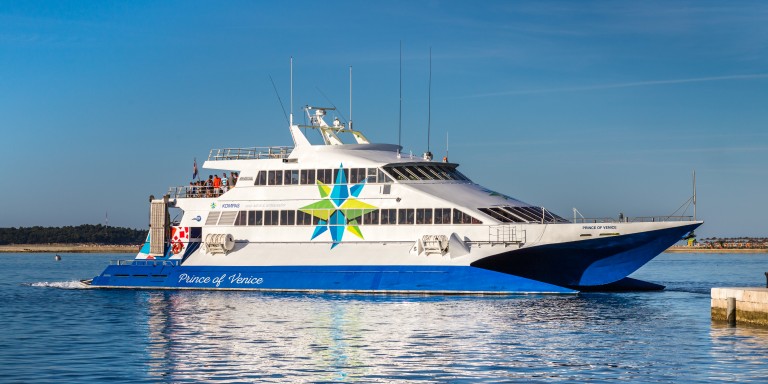
Prince of Venice in Poreč port / Adriatic Lines
During summer, namely from April to October, Venezia Lines have catamaran lines from Venice to Piran, Poreč, Pula, Rovinj, and Umag. Ticket prices range from 59 to 69 euros per person (450 to 520 kunas per person). It takes about three hours and 15-30 minutes to get in one direction, depending on the route. However, the schedule for 2021 has not yet been published.
Ferries from Istria to Italy also allow the transport of pets and bikes.
To find more ferries from Italy to Croatia, check the Istrian Sun webpage.
How to get to Istria by train?
If you decide to come to Istria by train, you can arrive very quickly using the lines from Ljubljana or Zagreb.
The line from Ljubljana can take you to Buzet or Pula every day and it takes four hours. There are no more trains going from Italy to Croatia.
If traveling from the Croatian capital, there are no direct train lines to Istria. However, you can take the train to Rijeka, but then travel by bus from Rijeka to Lupoglav, from where you can continue your train journey through Istria, to Pazin and Pula. The whole journey take four hours. You can book the train tickets on the Croatian Railways webpage.
Six railway stations in Istria are in Pula, Kanfanar (mentioned above as the center of Istrian Y), Vodnjan, Pazin, Buzet, and Lupoglav. Pula and Pazin are the main railway stations in Istria, from where you can quicky come to western Istrian cities of Poreč, Rovinj, and Novigrad.
Fun fact about travelling by train in Istria?
Did you know that Istria is home to the only island on the Adriatic coast connected by train? Its name is Uljanik and is one of the six islands in the Pula bay.
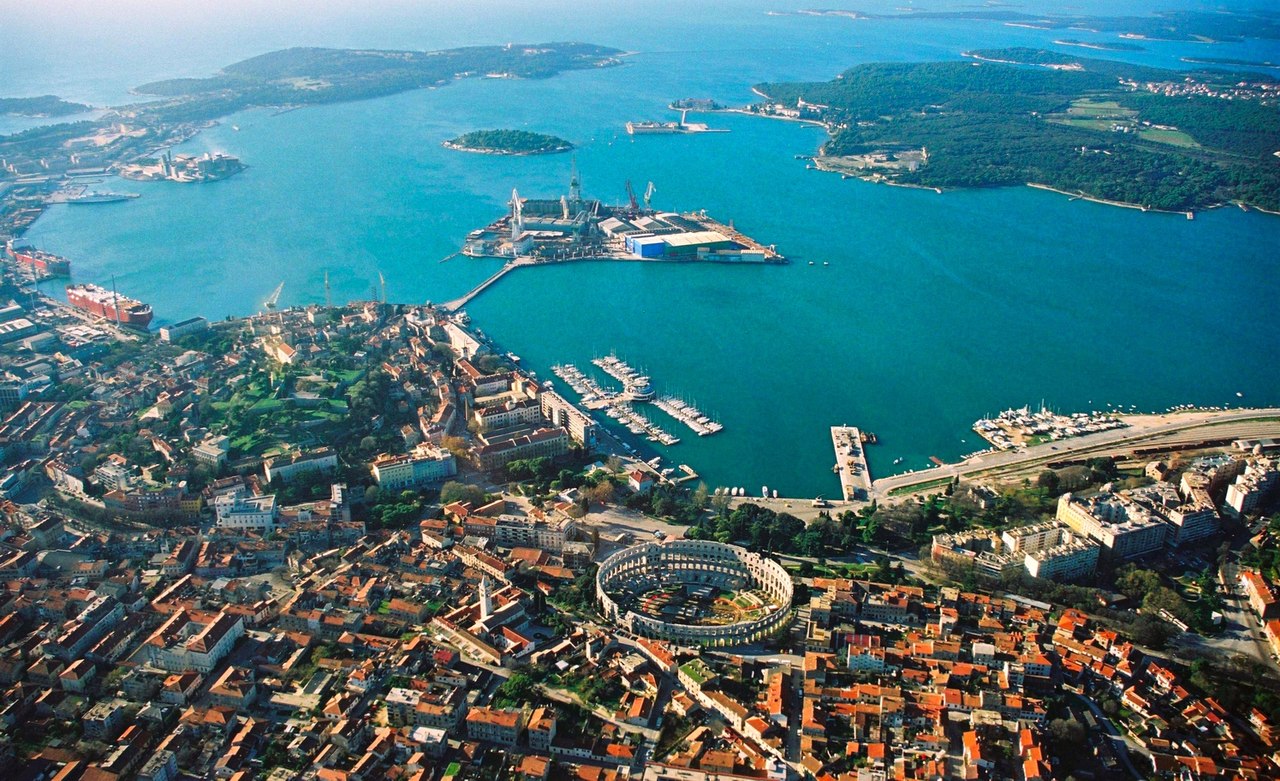
Pula and Uljanik island seen from above / Wikipedia
The name Uljanik, after which the nearby Pula shipyard was also named, comes from olive trees or, in Croatian, "ulike" that grew on it. Of all the olive trees, only one remained in the center of the island, surrounded by the Uljanik shipyard facilities, whose central plants are located on the island.
Interestingly, the industrial track for the shipyard Uljanik that goes from Pula railway station continues over the bridge, all over to the island of Uljanik. The bridge thus connects the island of Uljanik with the coast, making Uljanik the only Croatian island connected to the mainland by rail.
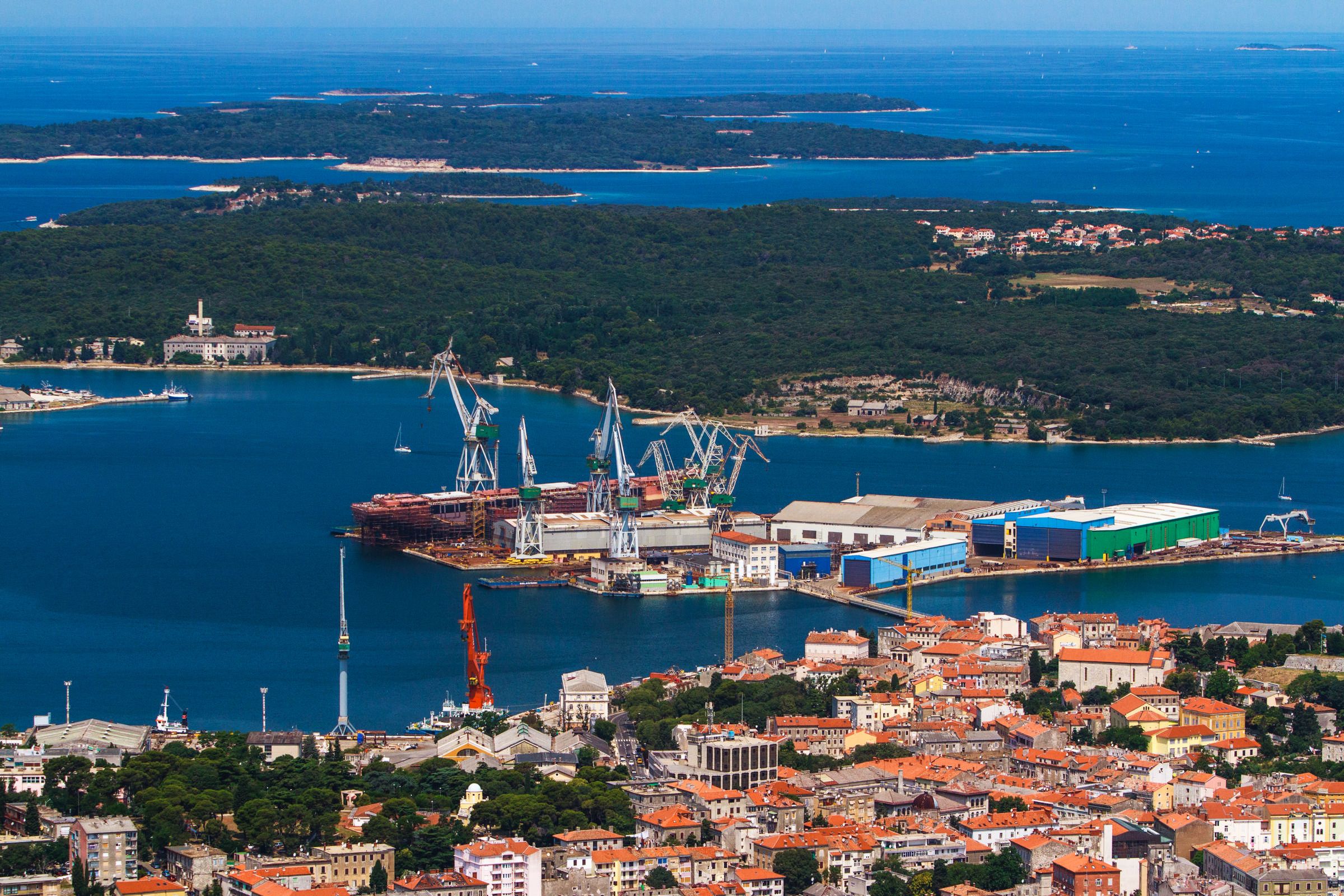
Uljanik shipyard's main plants on the island of Uljanik / Copyright Romulić and Stojčić
To follow the People Also Ask Google about Croatia series, click here.
PHOTOS: Outstanding Contemporary Croatian Architecture of the Year
February 10, 2021 – 10 of the most outstanding examples of contemporary Croatian architecture have been selected by the Association of Croatian Architects to compete in the extremely prestigious Mies van der Rohe Awards. Held only once every two years, they are the European equivalent of the Pritzker Prize for Architecture.
The Mies van der Rohe Awards are a really big deal. The greatest works of European architecture compete for recognition in the competition. The greatest success of Croatian architecture in the awards was attained by UP studios' Toma Plejić and Lea Pelivan, who received a special award for upcoming architects and had their high school in Koprivnica named the best building in that category in 2009. The success has had a considerable impact on their careers since.
Being held only once every two years, Croatian architecture projects completed since the closure of entries for the 2019 awards are eligible to be submitted. Here are the outstanding examples of contemporary Croatian architecture that will represent the country in 2022.
Cinema Urania Zagreb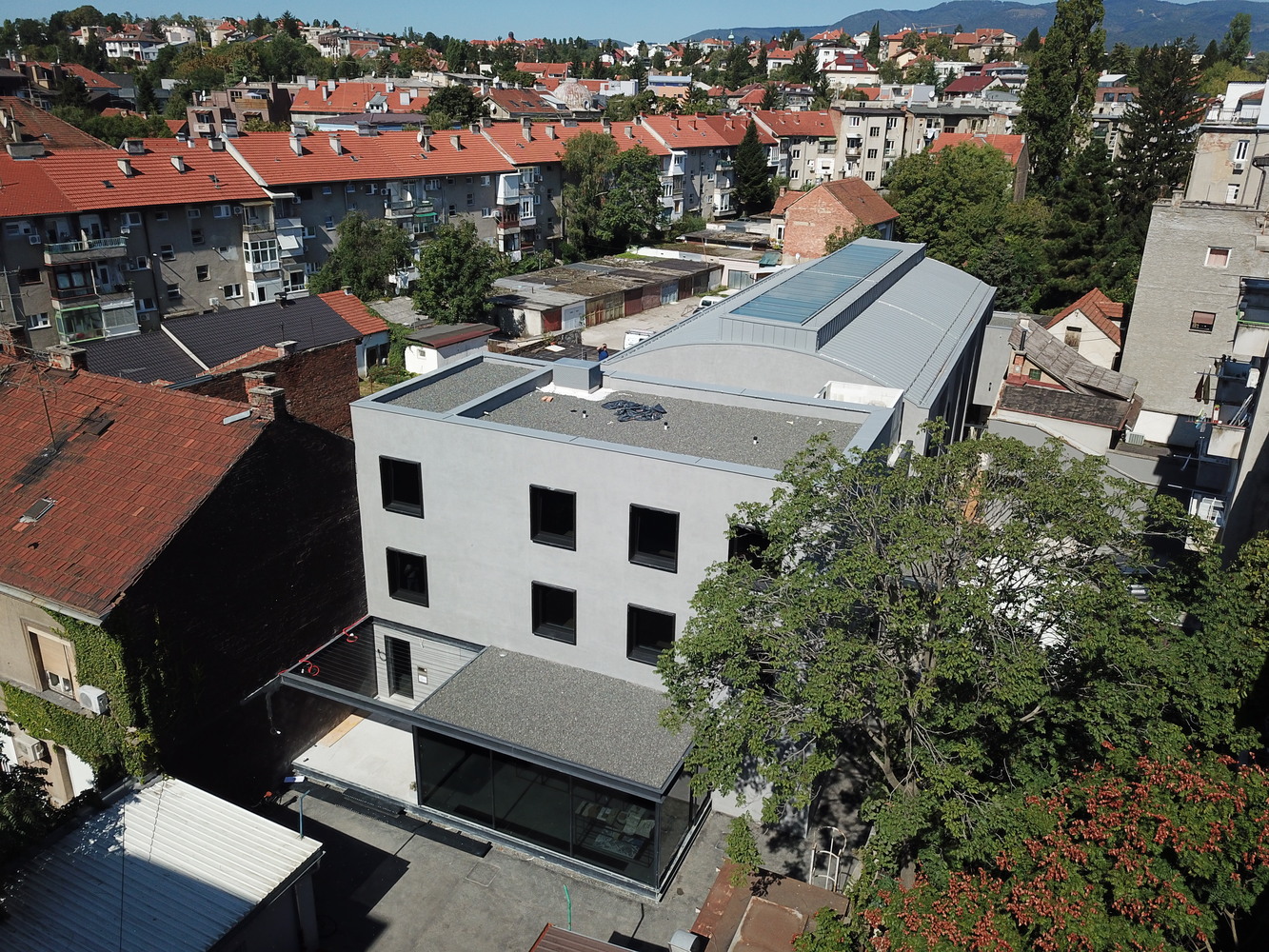
An old neighbourhood cinema built into the back streets near Kvatric. In their redesign, 3LHD preserved the best features from this early example of concrete engineering in Croatian architecture. They added a glass pavilion at the entrance, atriums and skylights, flooding the former darkness with the natural light needed for its new purpose as an event and work space.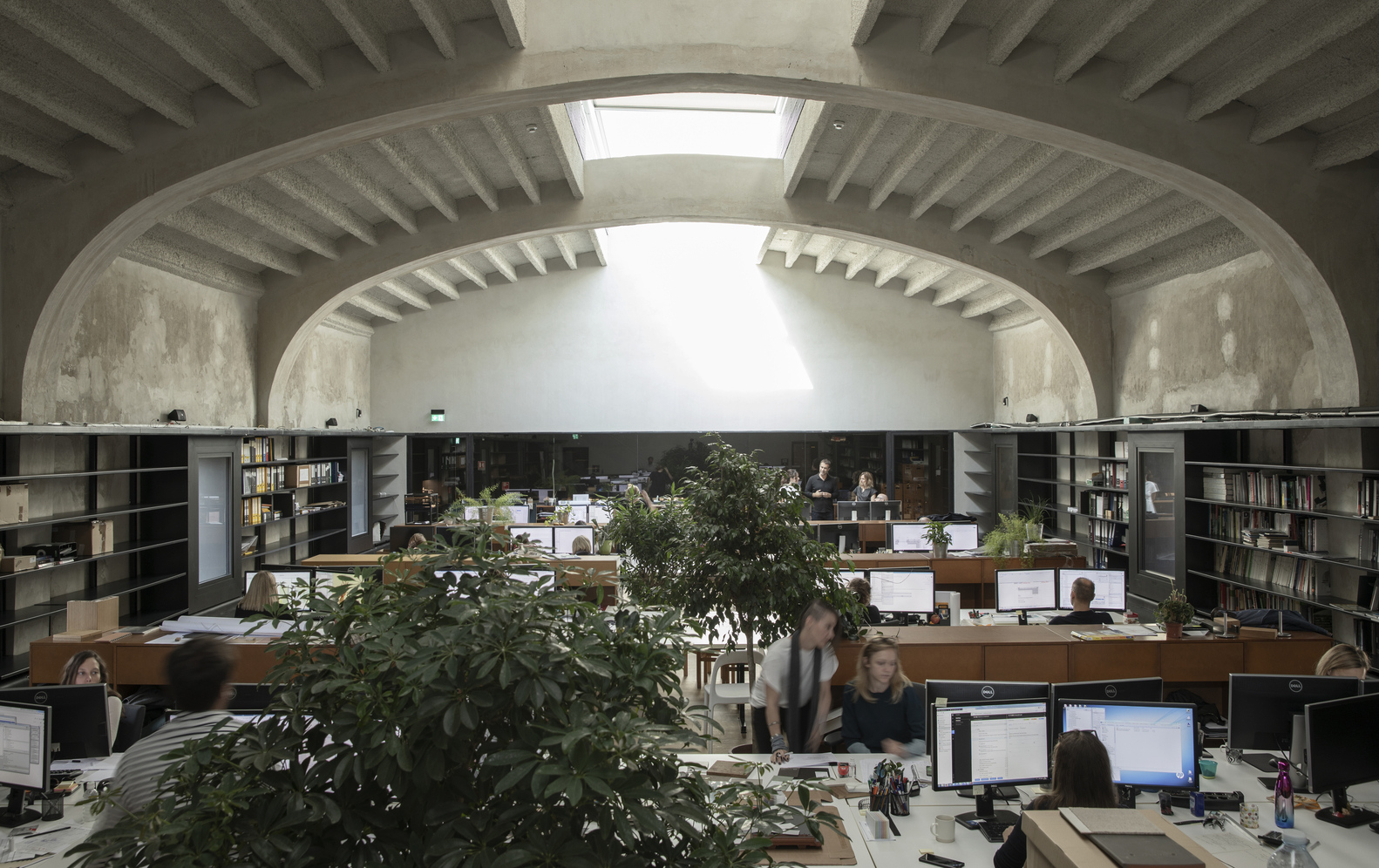 © Jure Živković
© Jure Živković
Grand Park Hotel, Rovinj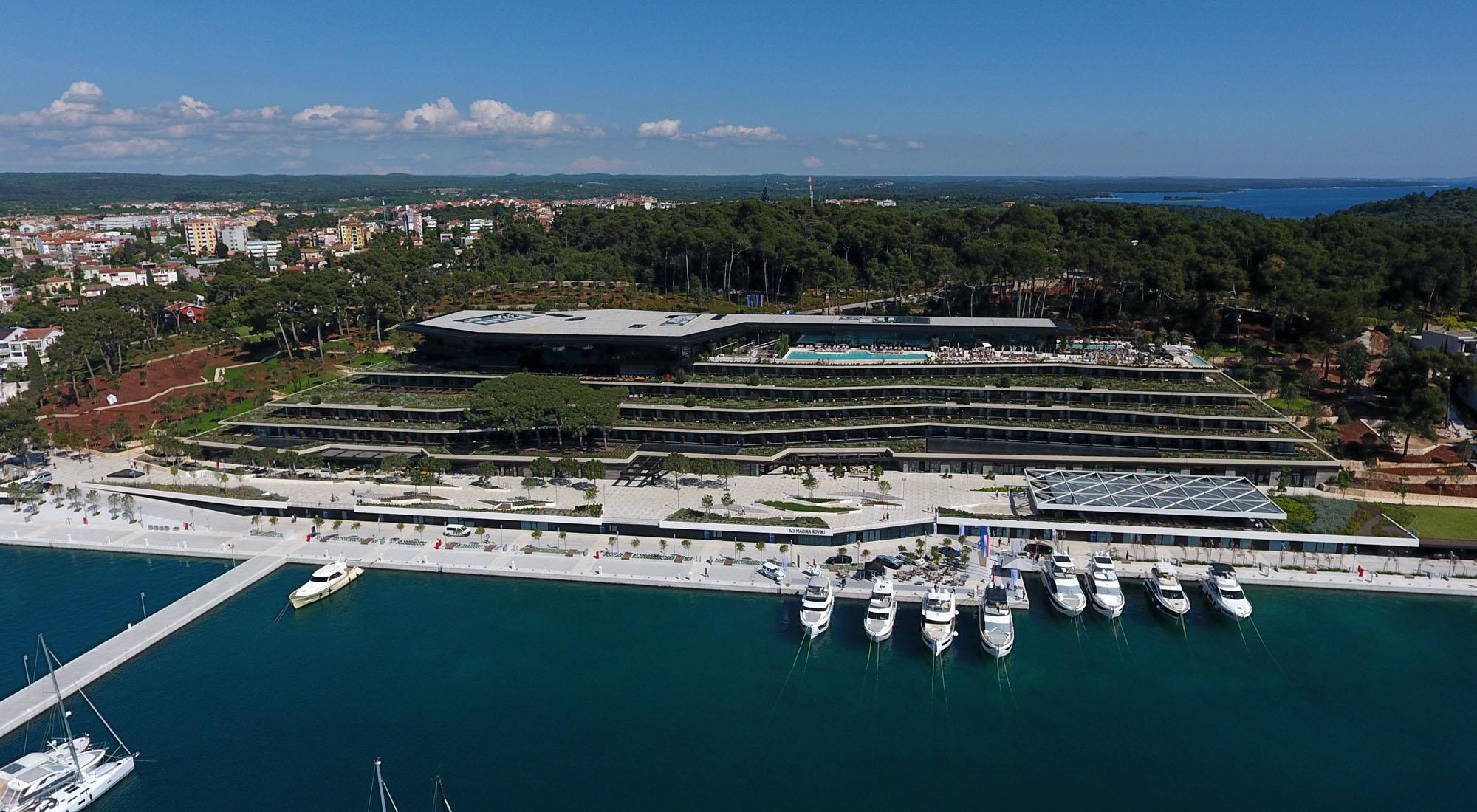
Sprawling widely across six stepped levels, the new luxury Grand Park Hotel and spa could easily have looked a long swipe of concrete. But, by places greenery on each of its staged roofs, architects 3LHD have ensured that no matter where you are in the 500-guest-capacity building, your view places you within a garden, looking out onto Rovinj Old Town and the expanse of the Adriatic. Croatian architecture at its most breathtaking.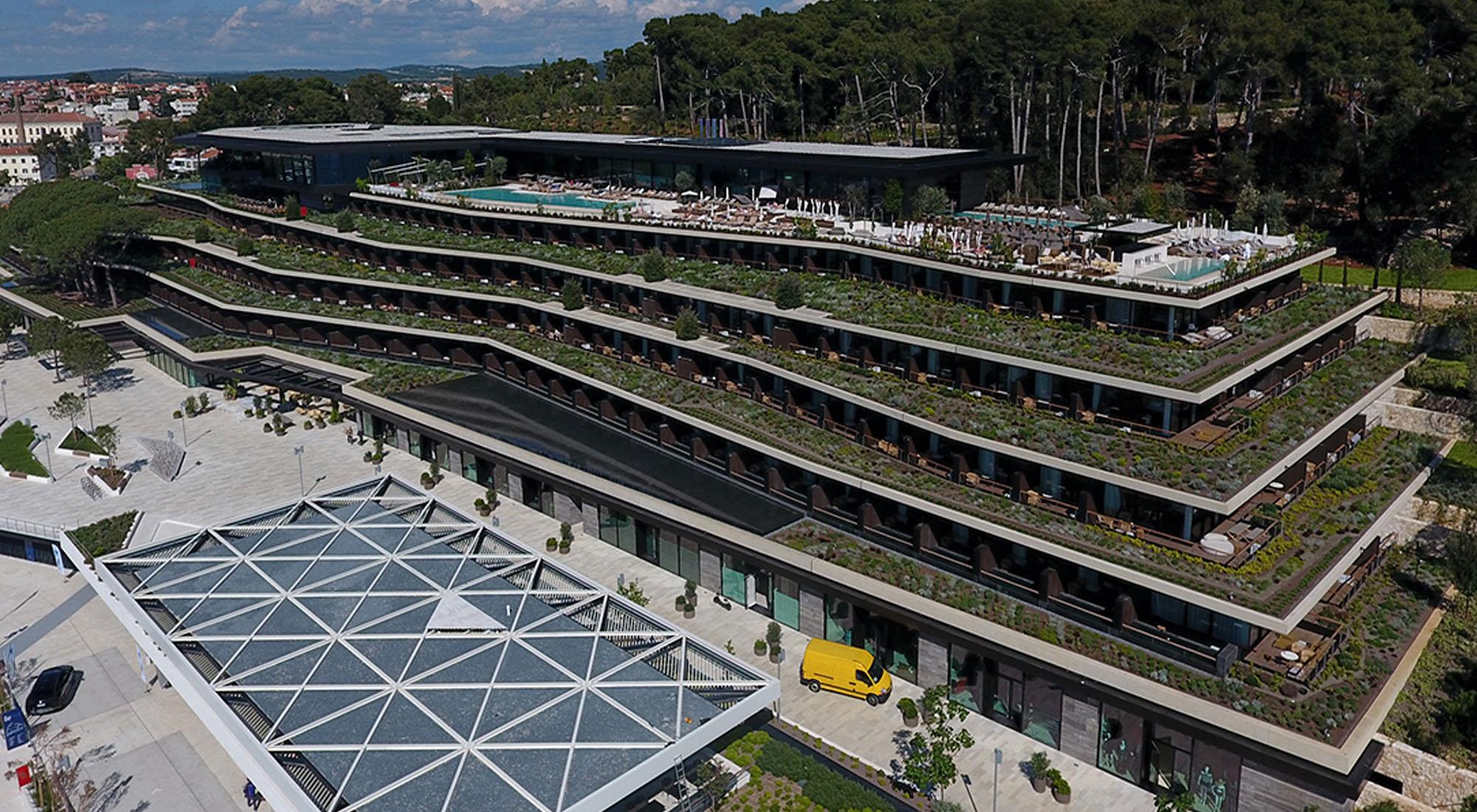 © Alukoenigstahl hr
© Alukoenigstahl hr
Ivanja Reka Elementary School, south Sesvete, east Zagreb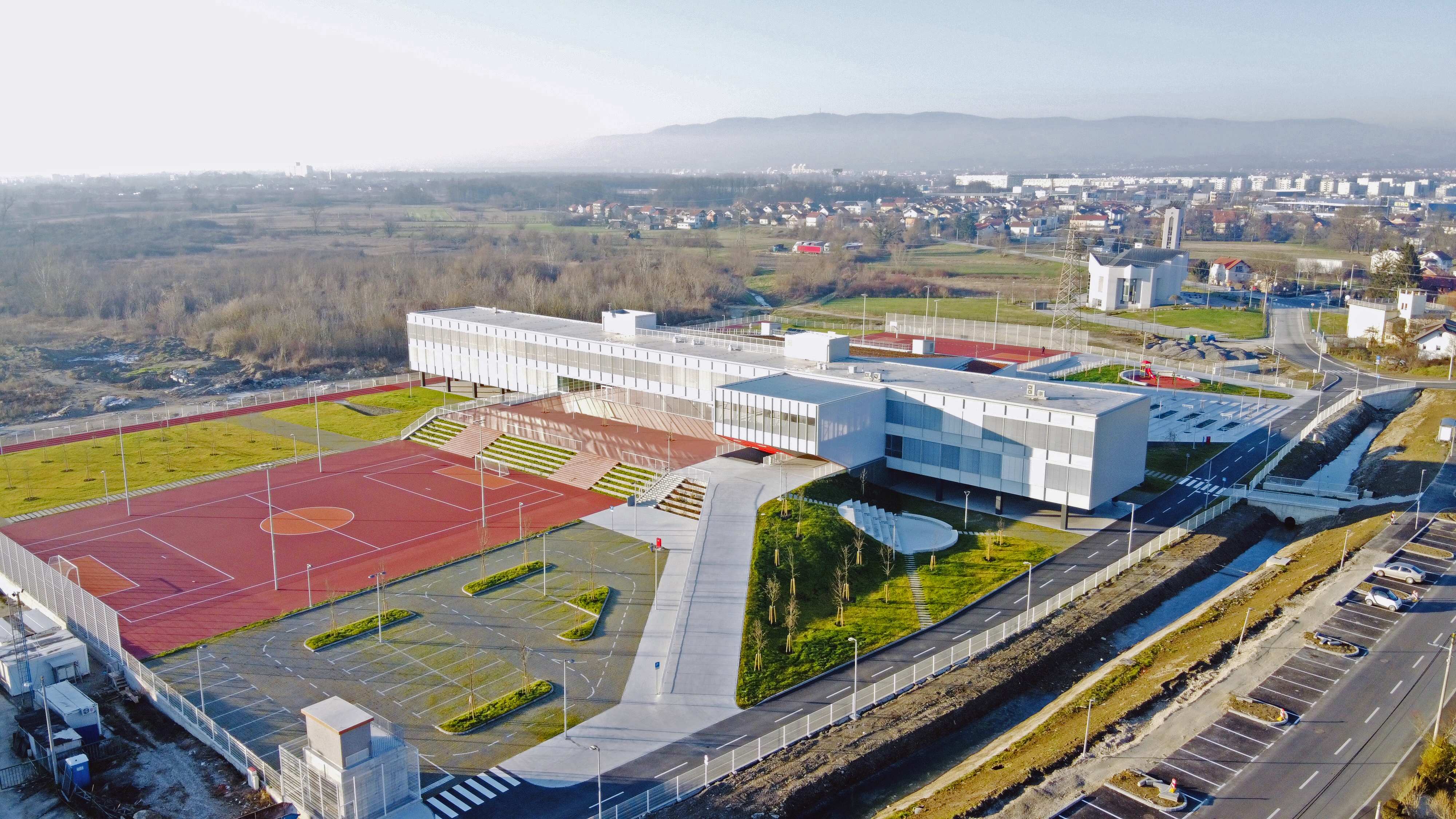
If every elementary school looked as pretty and was as well equipped as Ivanja Reka Elementary School in the south of Sesvete, eastern Zagreb, you could well believe daily attendance would never drop below 100%. Designed by a team of architectural authors (SUBMAP studios Marija Burmas and Ivo-Lola Petrić, and Jakša Kalajžić from JKA Arhitekti), the multi-level main building sits centrally, surrounded by sports, recreation and other facilities creating an impressive view for both those outside and within.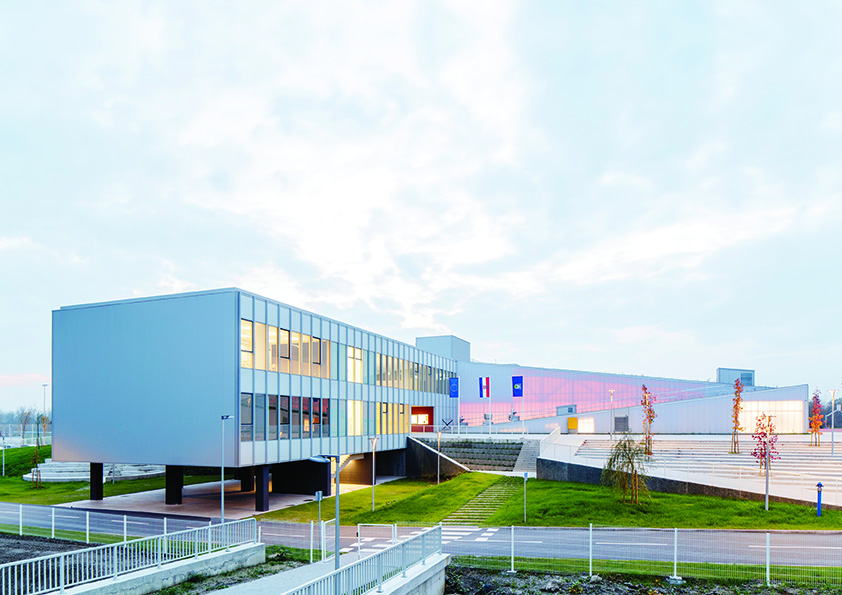 © Ivanja Reka Elementary School / Domagoj Blažević
© Ivanja Reka Elementary School / Domagoj Blažević
Roxanich Wine & Heritage Hotel, Motovun, Istria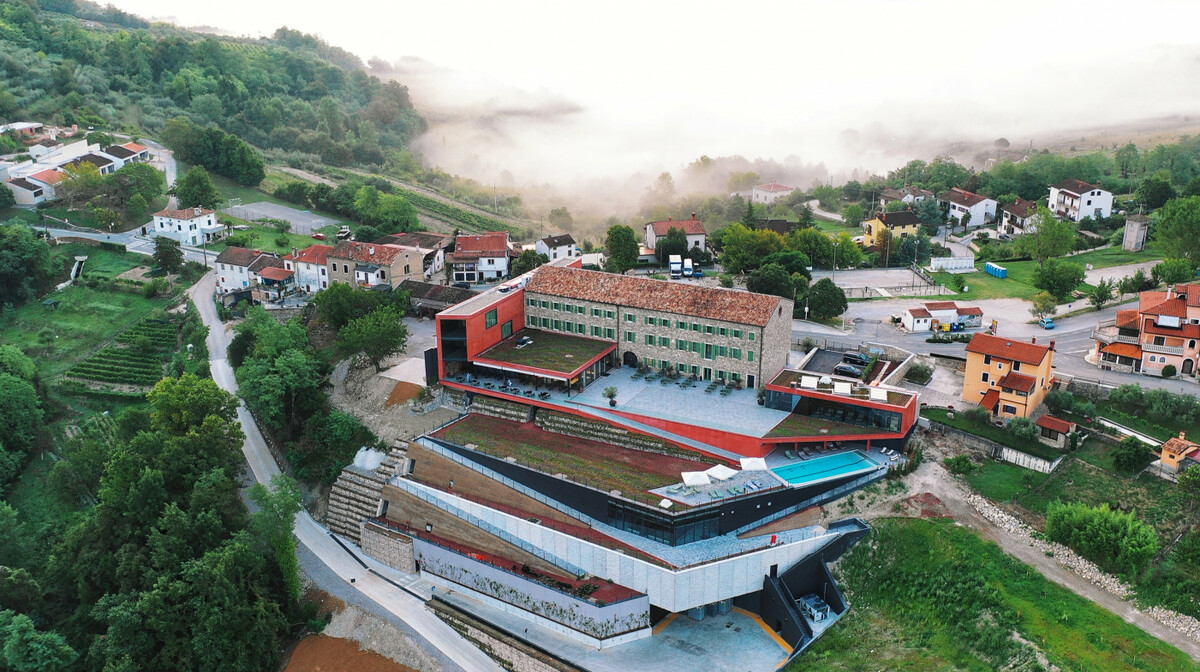
The view is unmistakably Istria. Vineyards carpet the land below and - rising above - the picturesque hilltop town of Motovun. Helmed architecturally by consistently bold Rijeka designer Idis Turato, this multi-level, multi-purpose redesign retains the traditional feel of its existing stone building and its purpose – there's a huge wine cellar beneath – but has opened up the space to give stunning views, not least over a sun deck that spectacularly reflects the sunrise and sunset. This is an active winery, with works and equipment all housed within its lower floors, not that you could tell from the 25 person capacity boutique hotel, restaurant and wine shop upstairs.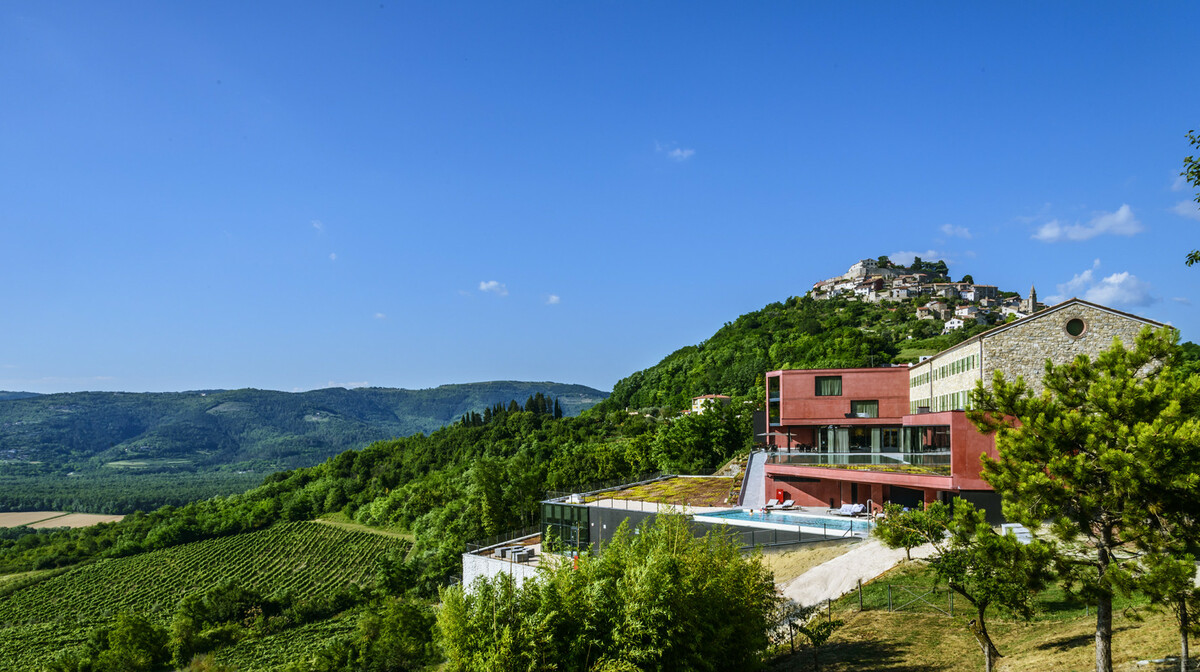 © Roxanich.hr
© Roxanich.hr
Four Houses for Four Brothers, Diklo, Zadar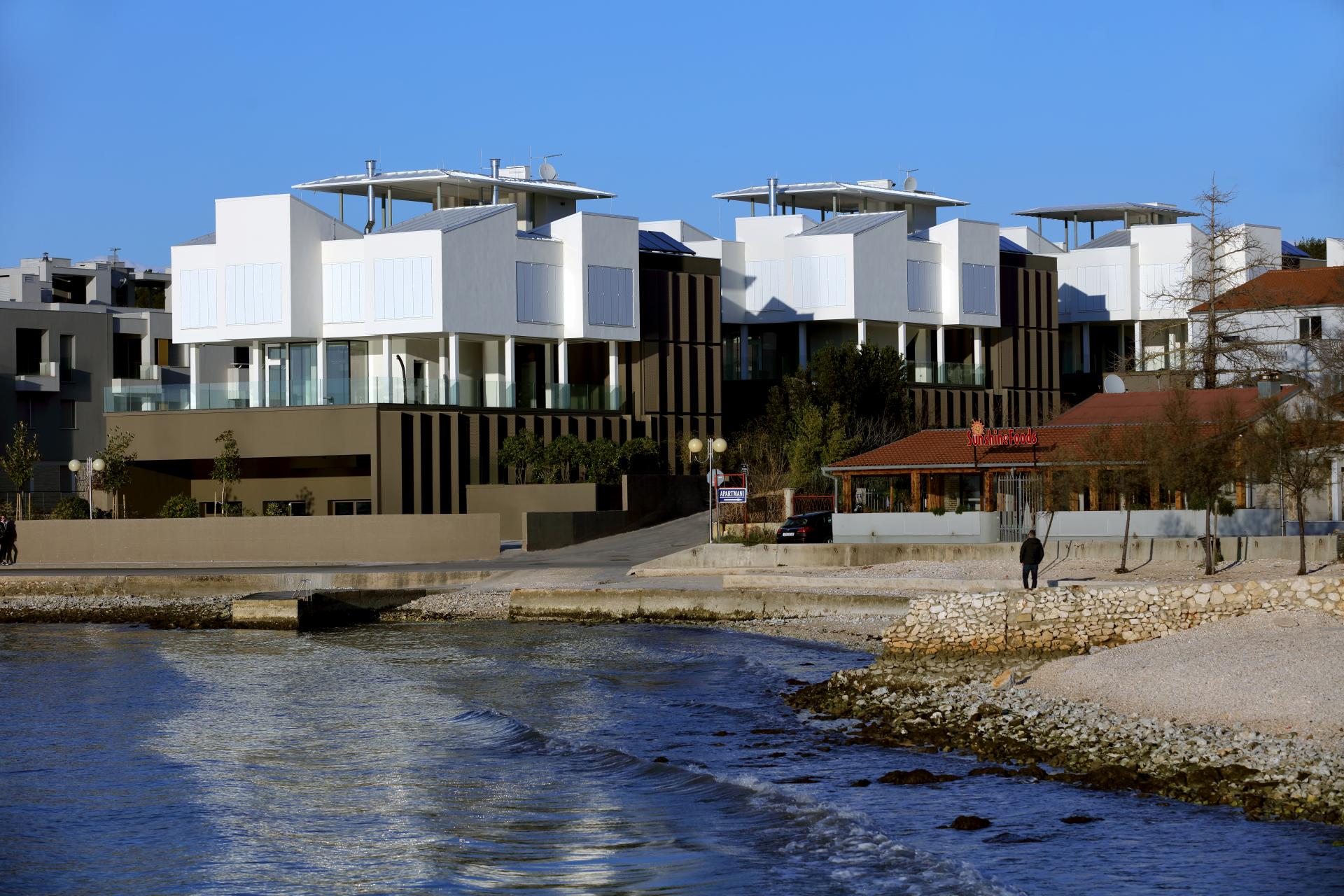
Judging from a theme of project titles used by architects Iva Letilović and Igor Pedišić, we're not sure that Four Houses for Four Brothers was actually commissioned by four brothers or that four live there. But, you could well believe they could. The ultra-modern set of independent houses, located next to a beautiful stretch of coast in a north Zadar neighbourhood, was specifically designed to address a distinctly Croatian reality – how to open up some of your dwelling to seasonal guests while you remain at home. The design separates the buildings clearly into separate quarters which allow privacy, comfort and minimal encroachment for both visitors and residents.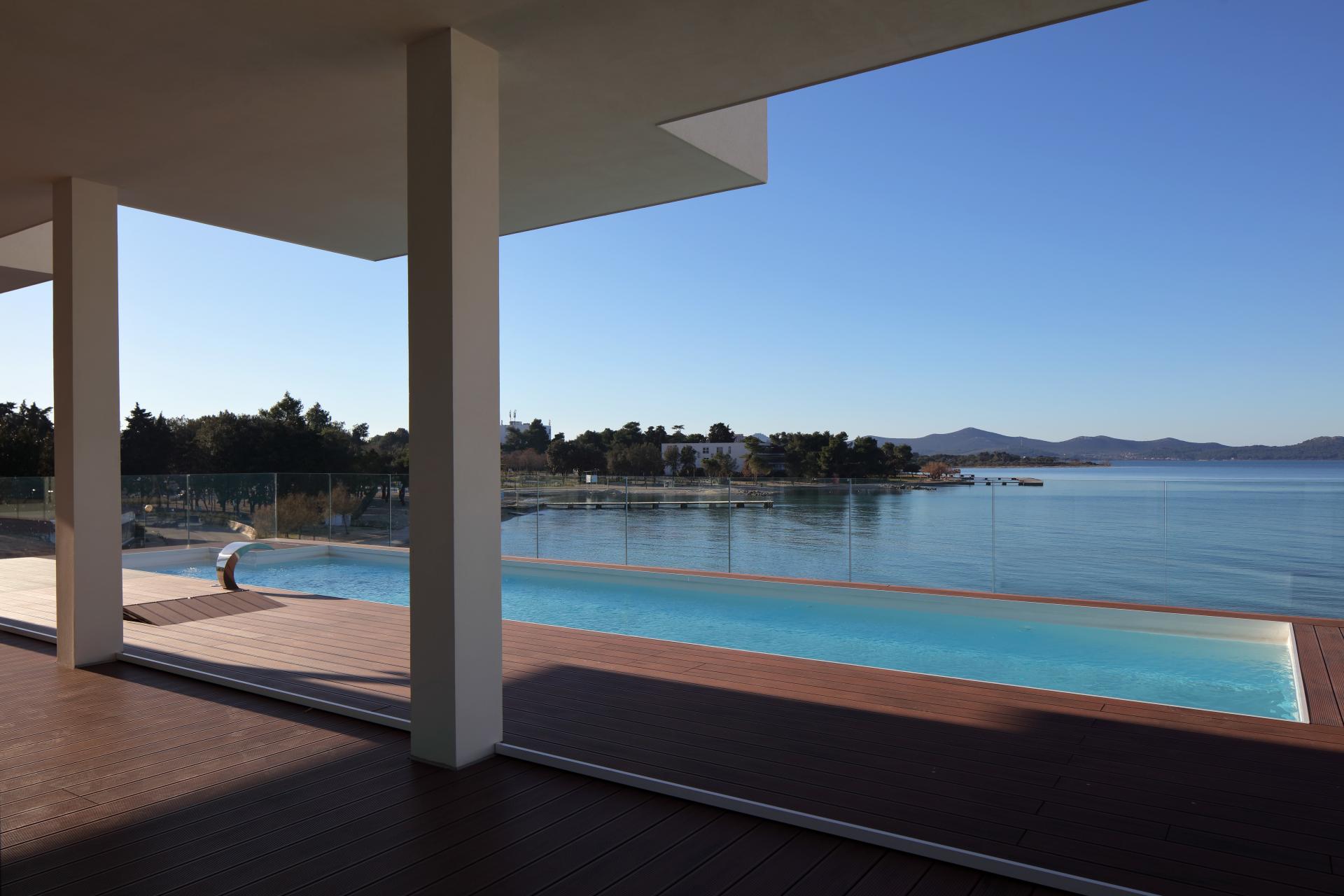 © Igor Pedišić
© Igor Pedišić
Galić Winery, Kutjevo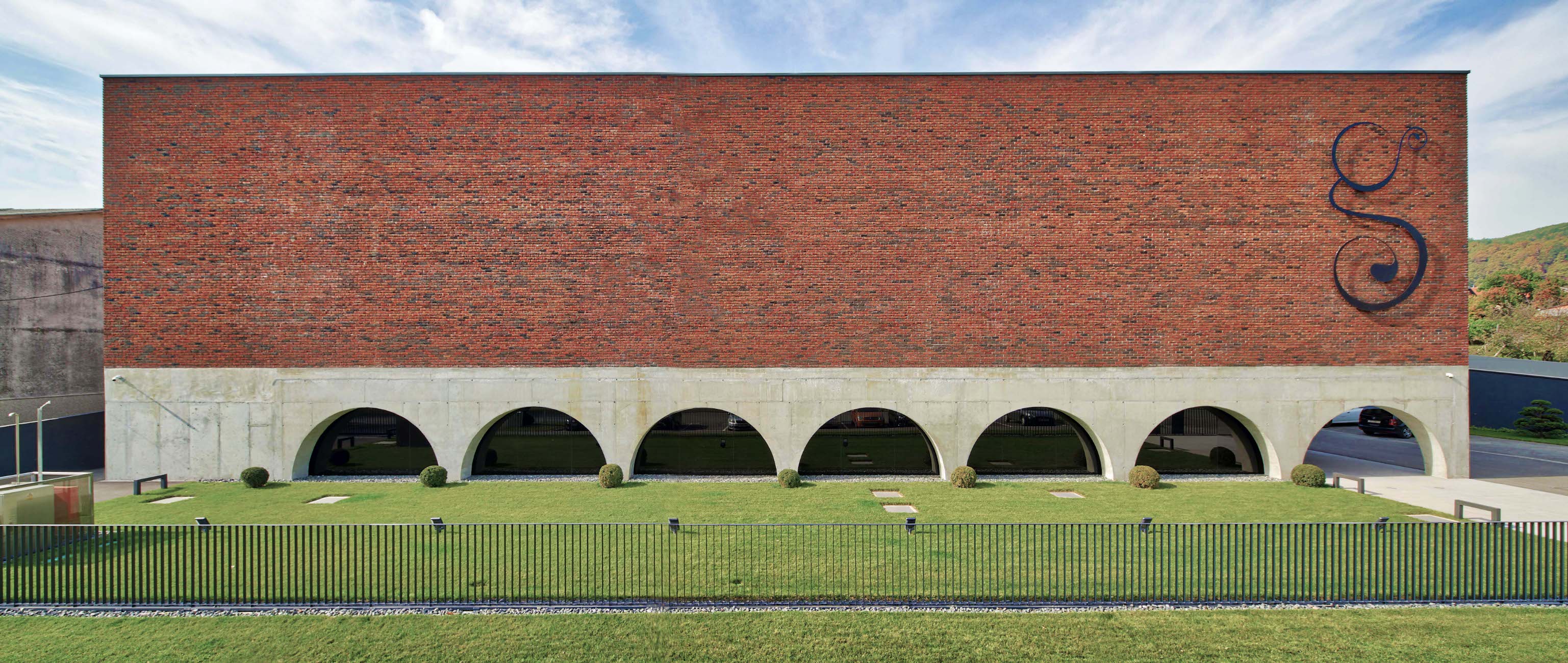
Award-winning outfit Zagreb-based studio Dva arhitekta have an existing, jaw-dropping design for a rural winery commissioned by famous makers Galic. However, that project, as yet, remains unrealised. But, their winery for Galic in the centre of Kutjevo town is complete. Melding the traditional and the contemporary, the upper section of the building is a bold and unblemished red brick, adorned with the winemaker's unmistakable logo. Beneath, concrete arches invite your eyes into the actual wine cellar – neat rows of barrels, protected behind glass walls that are set back from the facade. Brilliant!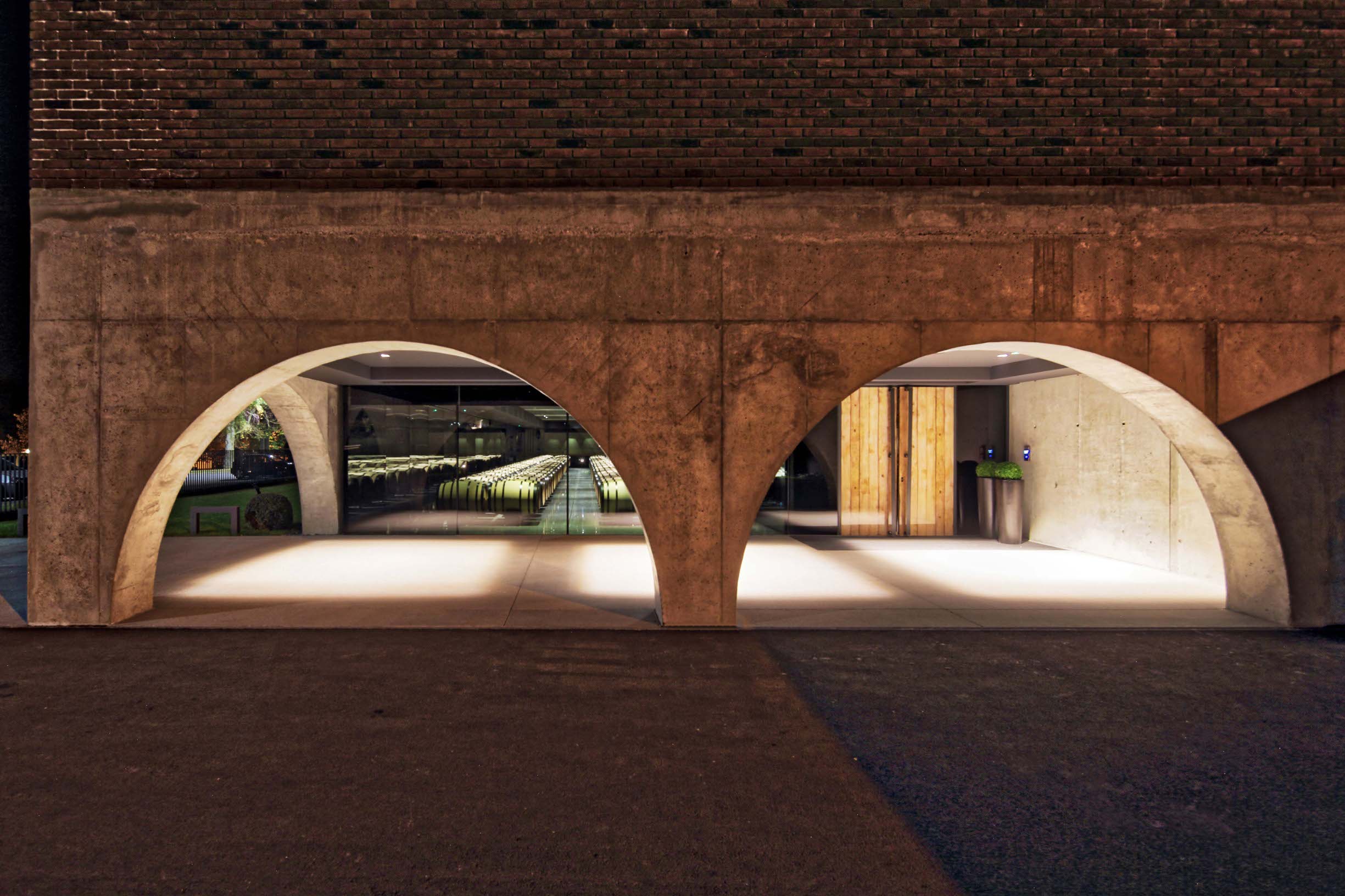 © Damir Fabijanić
© Damir Fabijanić
Seecel Centre, Zagreb
Designed as a regional centre for the development of entrepreneurs and its construction costs generously part-funded by European money, the Seecel Centre arrived long overdue and does not house its intended inhabitants. Such matters are best left for different articles as, here, we're concerned with the undeniable finery of this building's architecture and appearance. Holding space for accommodation, offices, communal collaboration, education and presentations, the five-floored building uses ultra-modern building materials and construction methods to make it low-energy, its great blocks of covered concrete, with glass windows set further back, echoing old fortifications. It was designed by Igor Franić who, in Croatia, is perhaps best known for the Museum of Contemporary Art in Zagreb and completed by him and his team at SZA / Studio za arhitekturu d.o.o.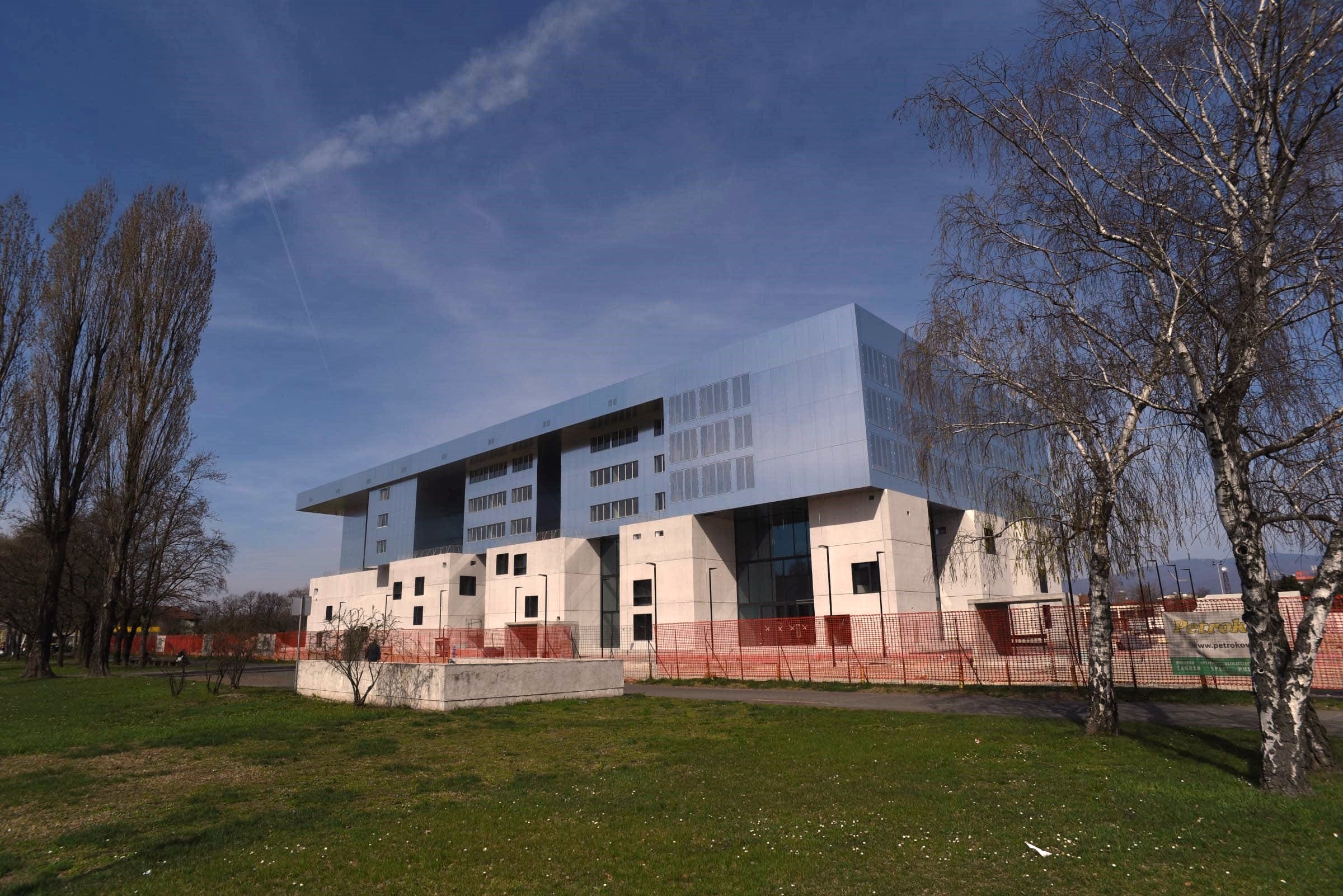 © Site Project d.o.o.
© Site Project d.o.o.
Trg Poljana, Šibenik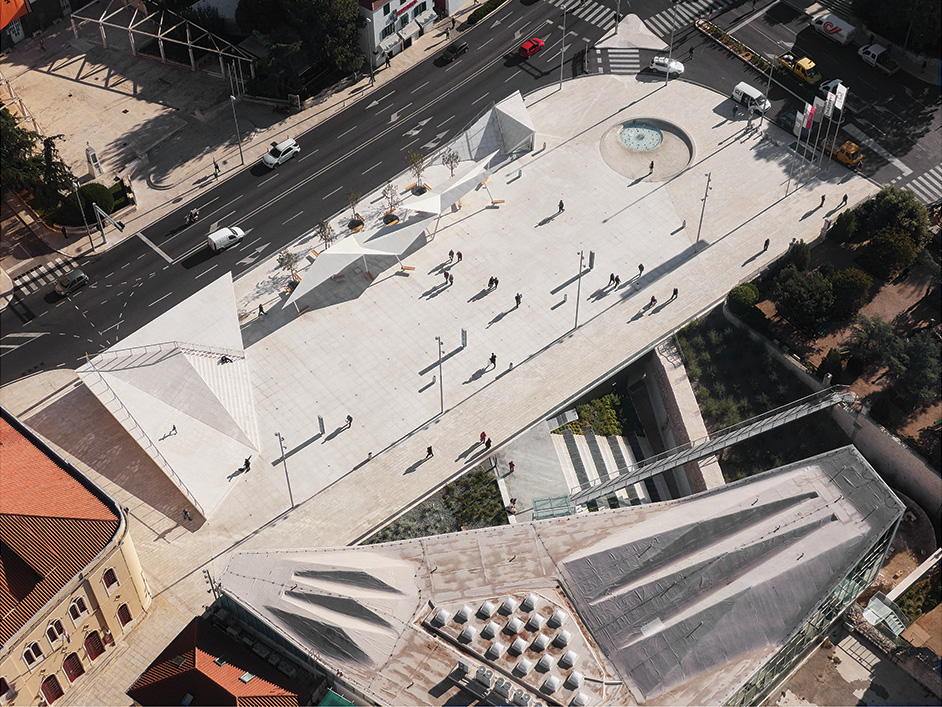
Not a small amount was asked of project architects Atelier Minerva from Dubrovnik in the task to create Trg Poljana in Šibenik. The site had long been earmarked for a much-needed, official town square – a place for events and public gatherings. But, the town was also woefully short on parking. By burying a multi-level car park beneath the open space, the architects successfully met both demands. Triangular shapes sit at an angle above shaded seating, echoing the inclines on the roof of the Juraj Šižgorić City Library opposite. Clever.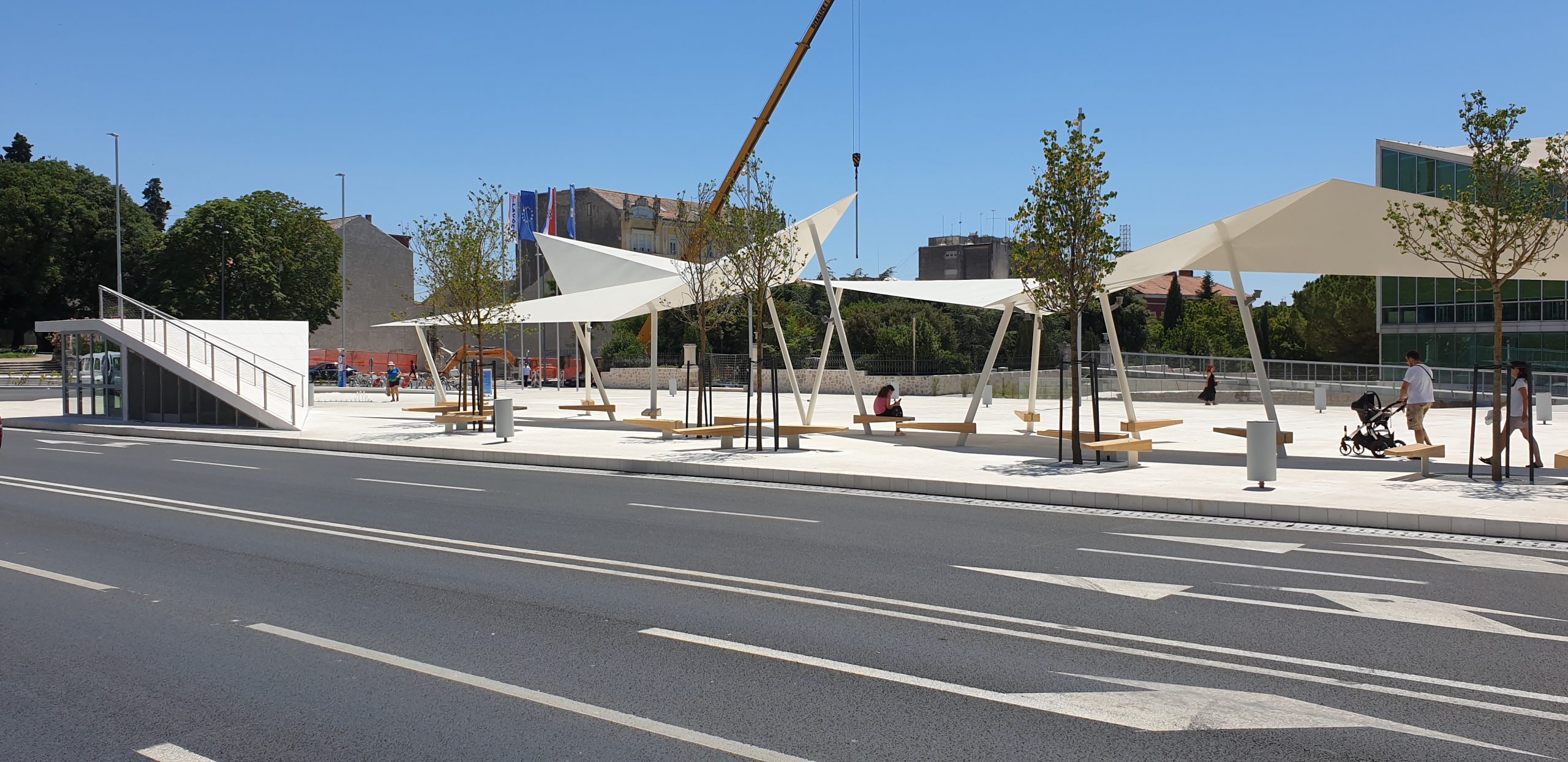 © Ervin Husedžinović / Eccos-inzenjering
© Ervin Husedžinović / Eccos-inzenjering
Homestead on Hartovski vrh, Žumberak, Zagreb County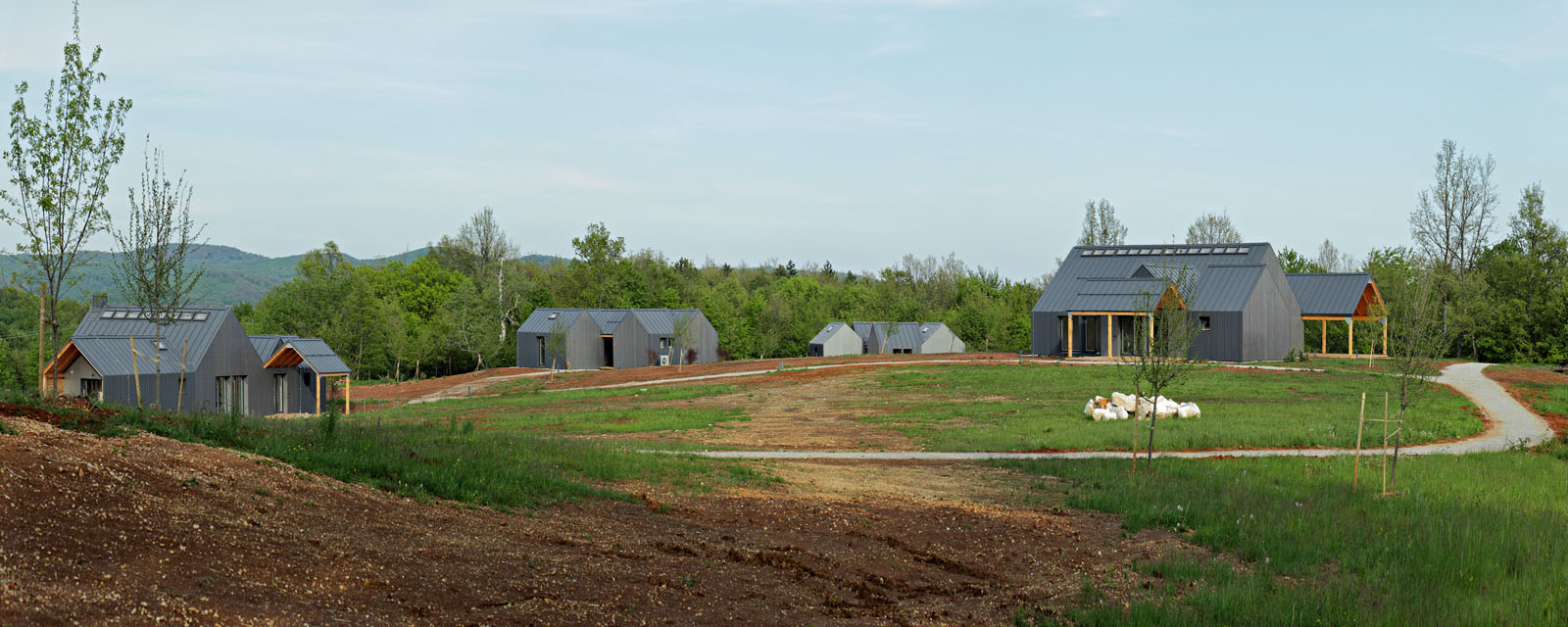
A collection of multi-purpose rural buildings, Homestead and Meditation Centre on Hartovski vrh was commissioned and designed for use by the Buddhist Center Zagreb. Their aim was to relocate activities such as chan, yoga, meditation, healthy living and teaching to a peaceful retreat outside of the city. Architects Branimir Rajčić and Mariela Žinić began the project in 2015, with the completed site arriving in 2019. Modern building materials are used, but not so the striking collection seems out of place within a partially agricultural setting. The set of buildings includes a residential dwelling and a larger hall for meetings and activities, both of which use large windows to allow the light and nature to flood in. © Robert Leš
© Robert Leš
Square of Traditional Crafts, Varaždin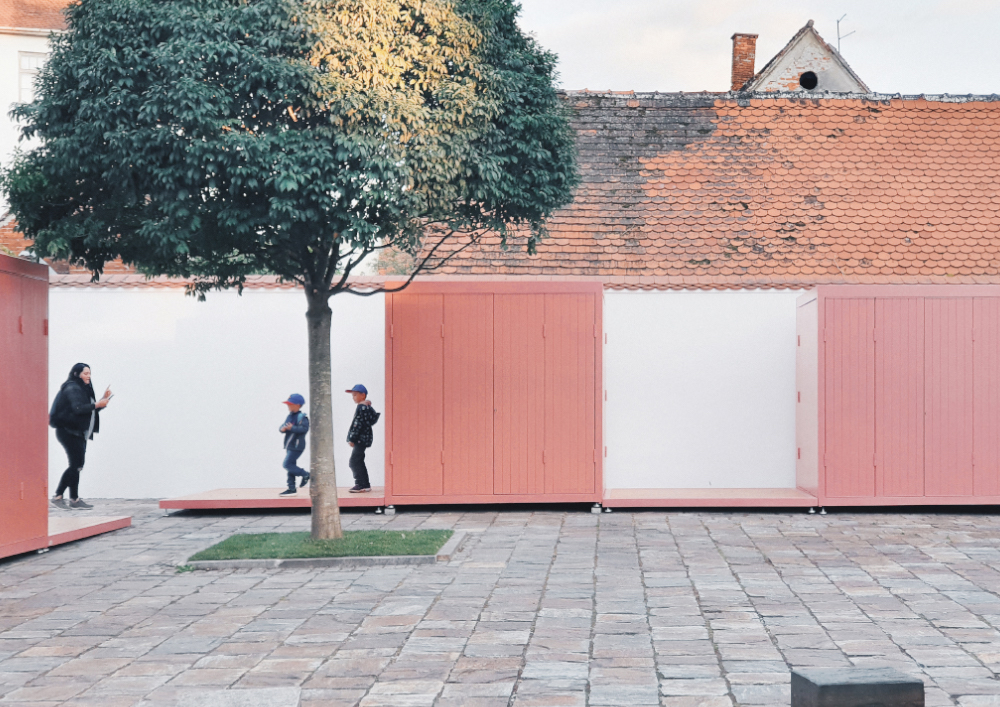
A tricky task was given to architects Studio Konntra – how to enliven and modernise a traditional old square in the centre of one of Europe's best-preserved Baroque Old Towns. They did this by constructing transportable kiosks to house small outlets for local artists and craftsmen that cater to visiting tourists who come to the square. When occupied during the day, the plain wooden interiors allows the crafts to take centre stage. But, after closing time, the outsides of the wooden doors are brightly coloured and adorned with paintings, a welcoming environment for residents to use at night.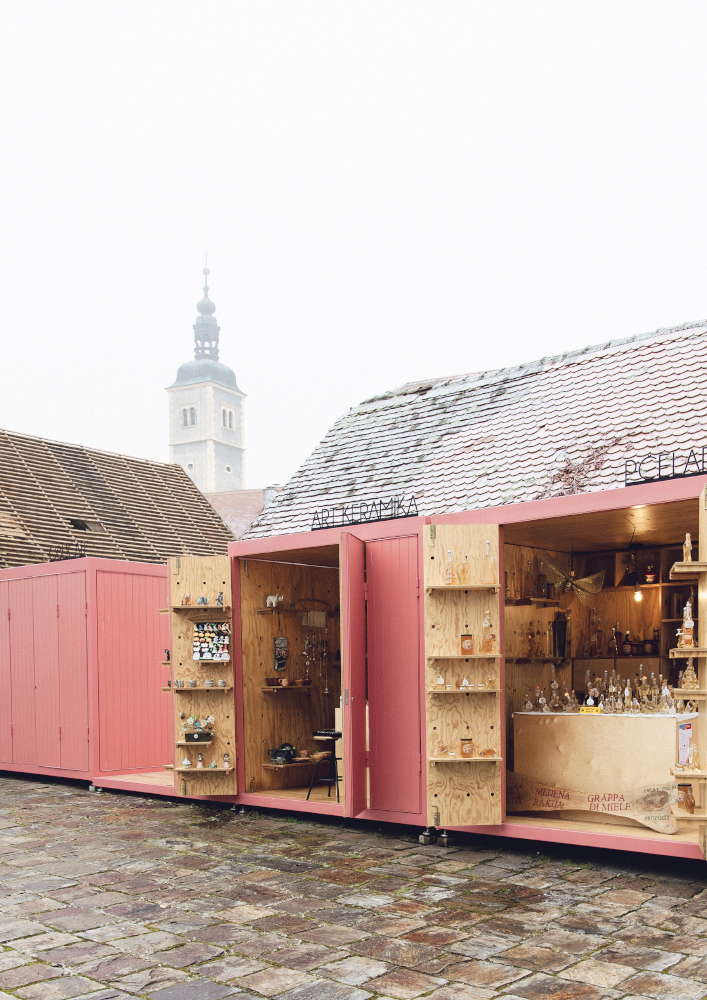 © Studio Konntra
© Studio Konntra


